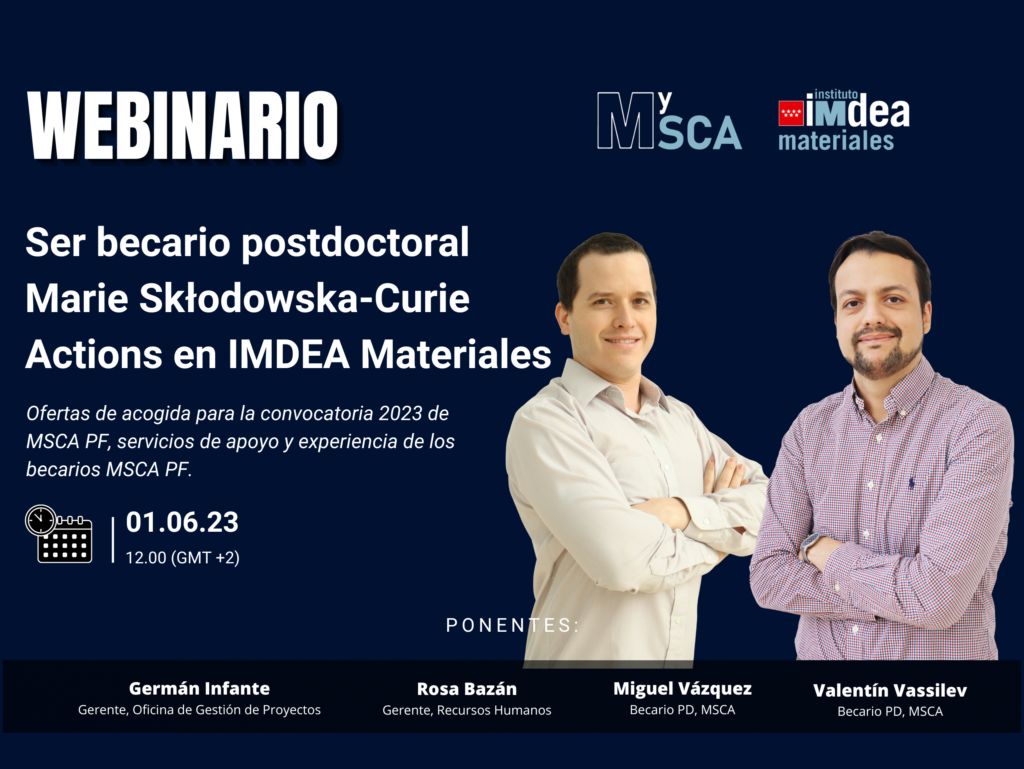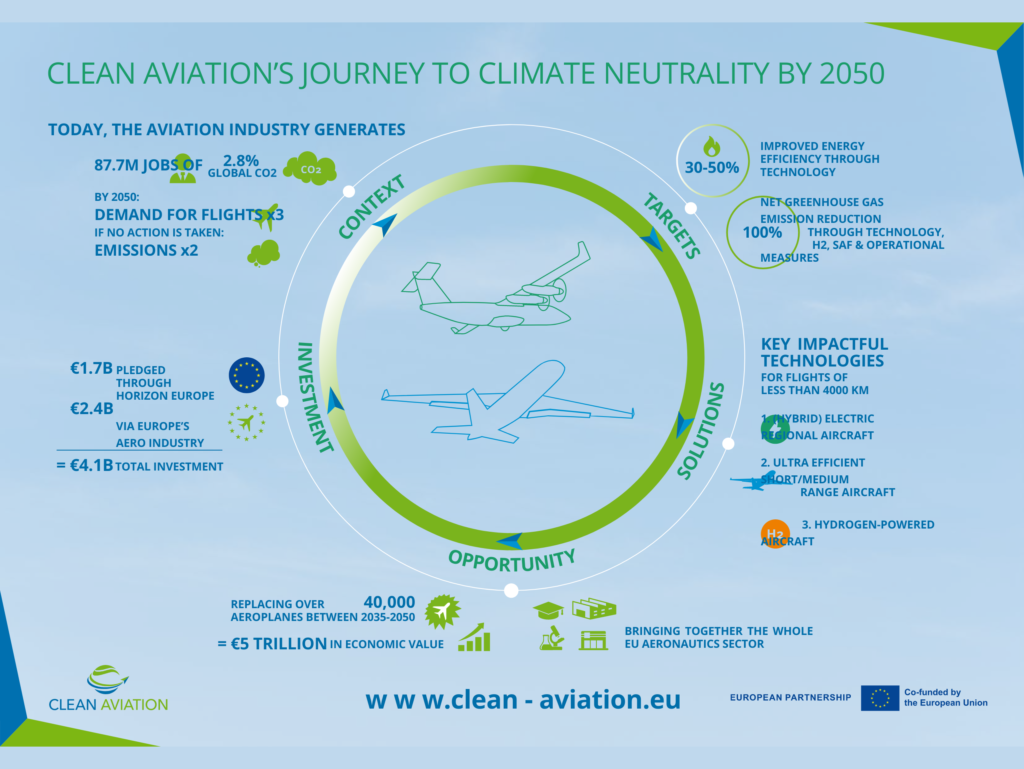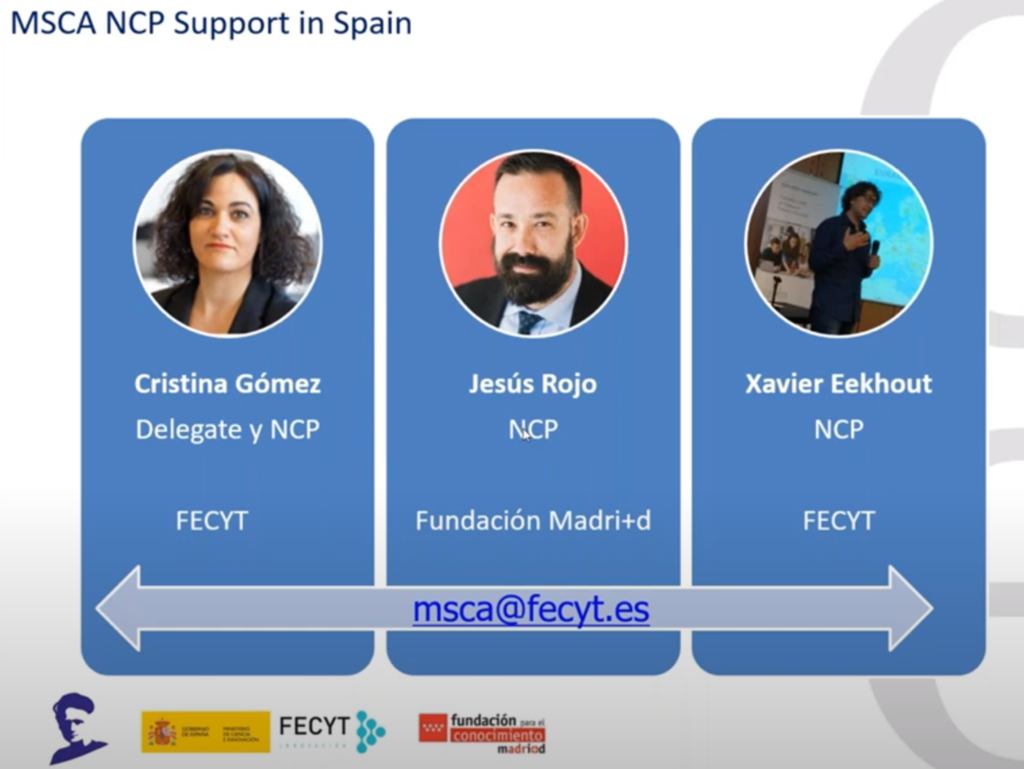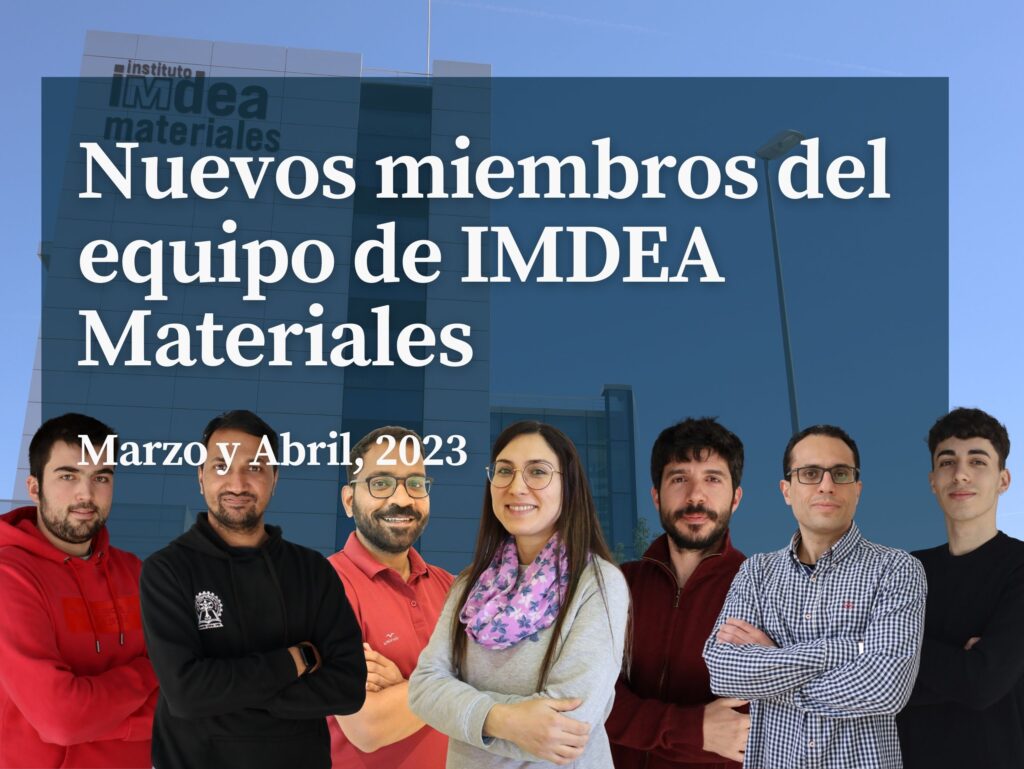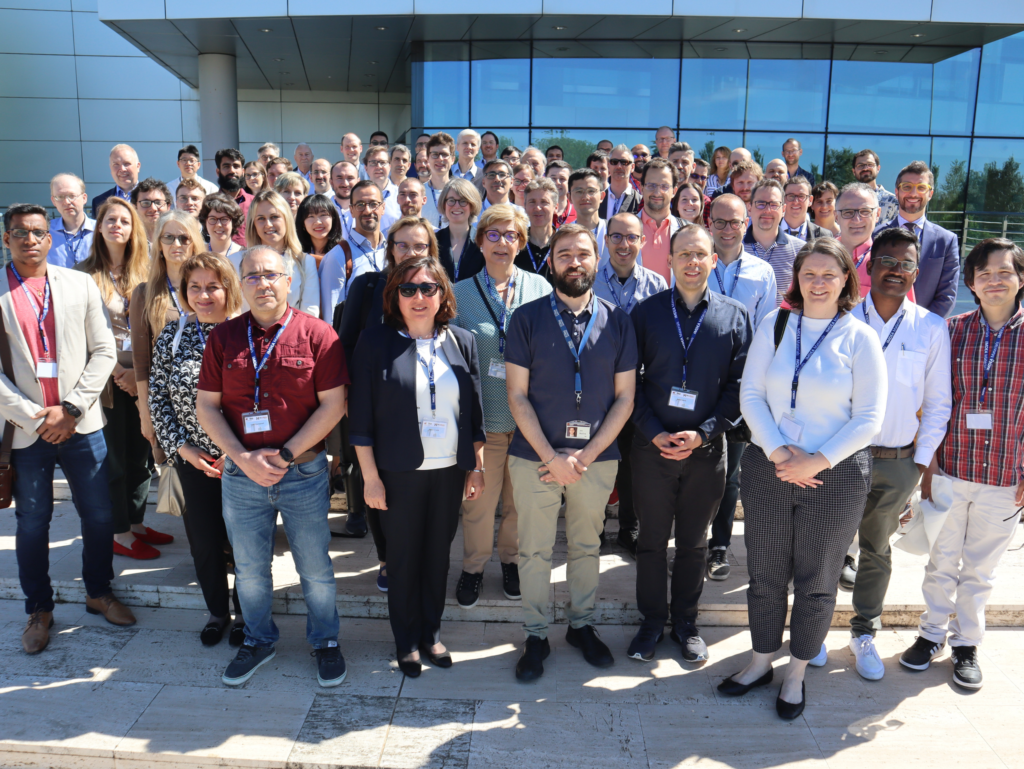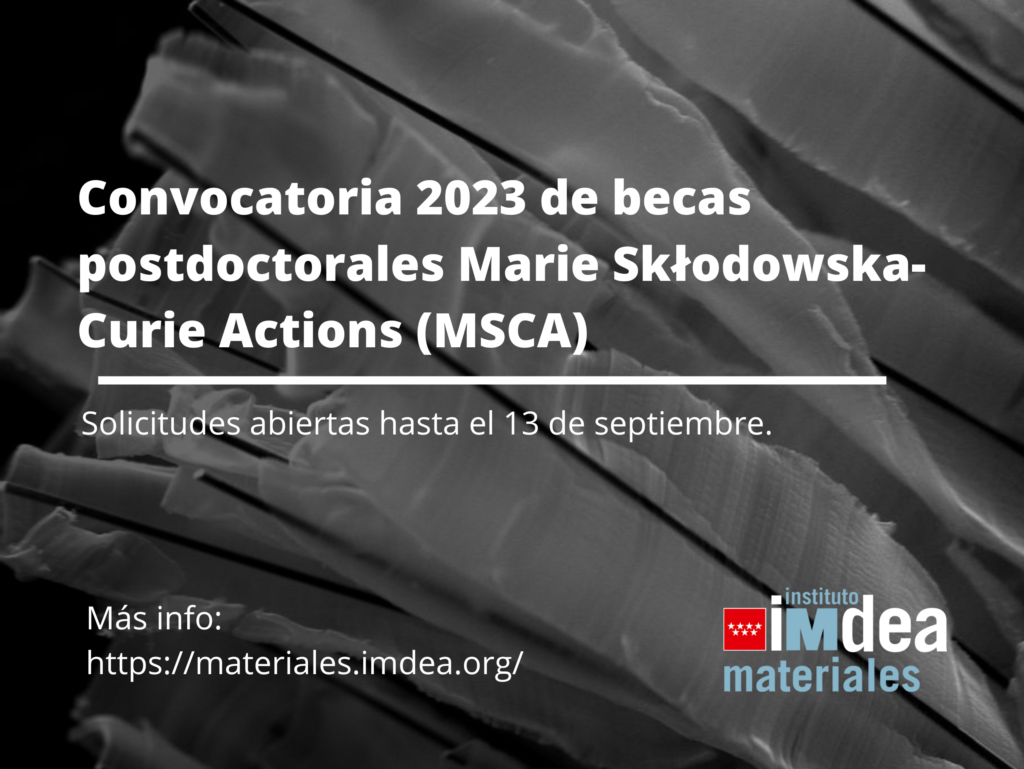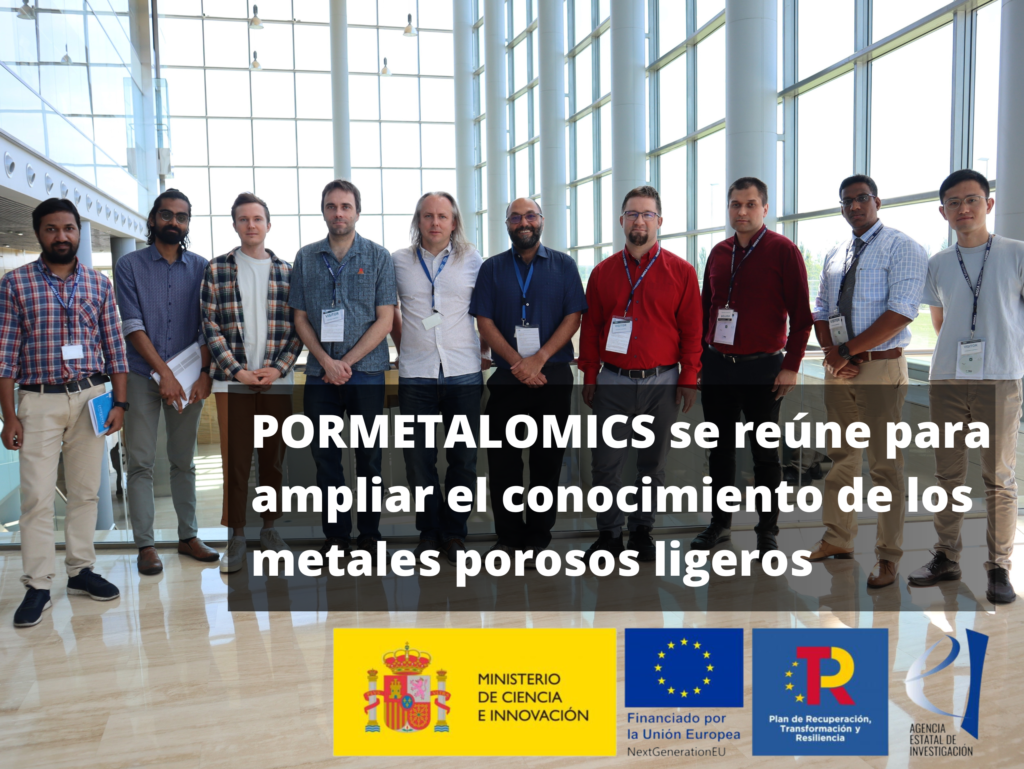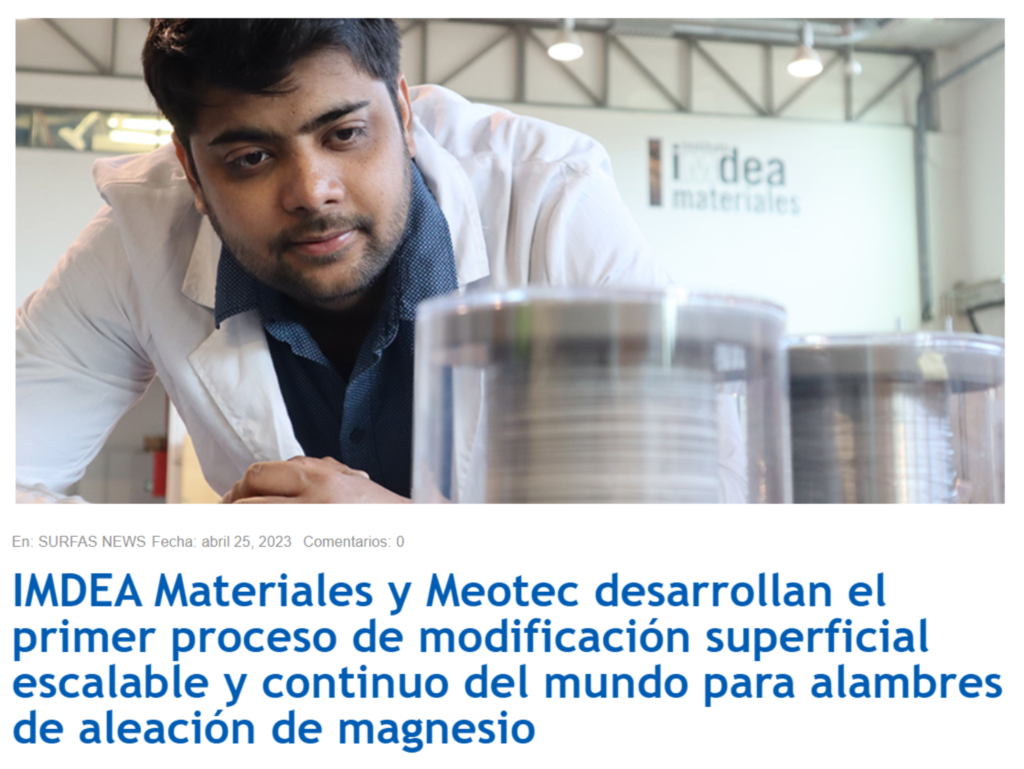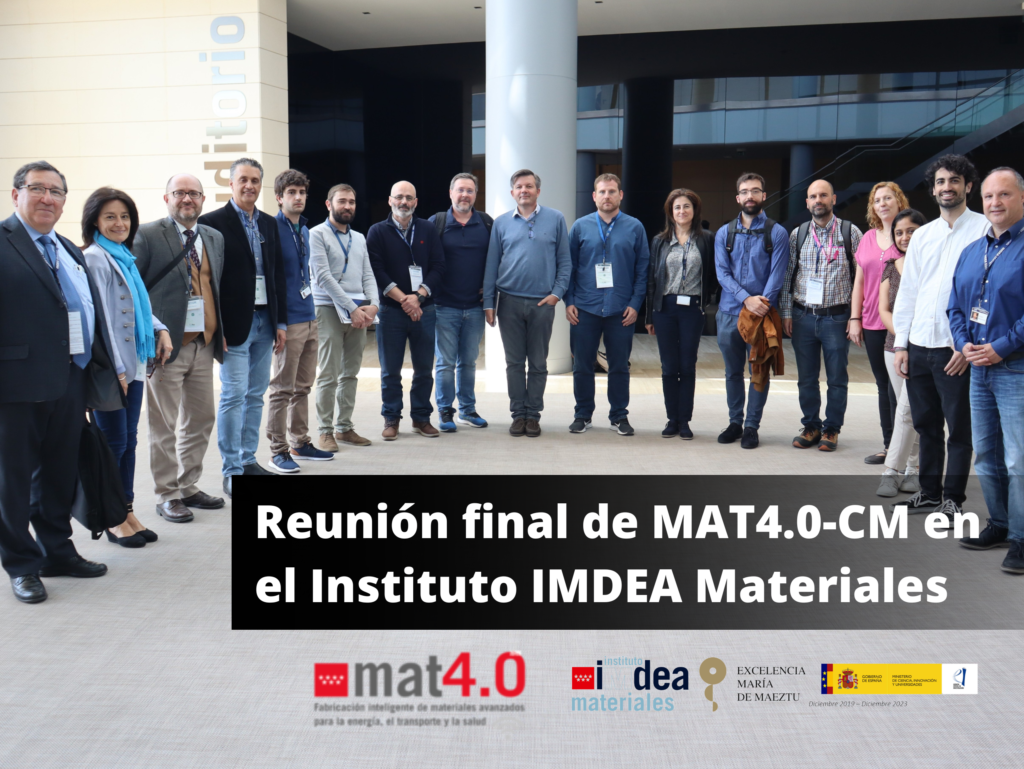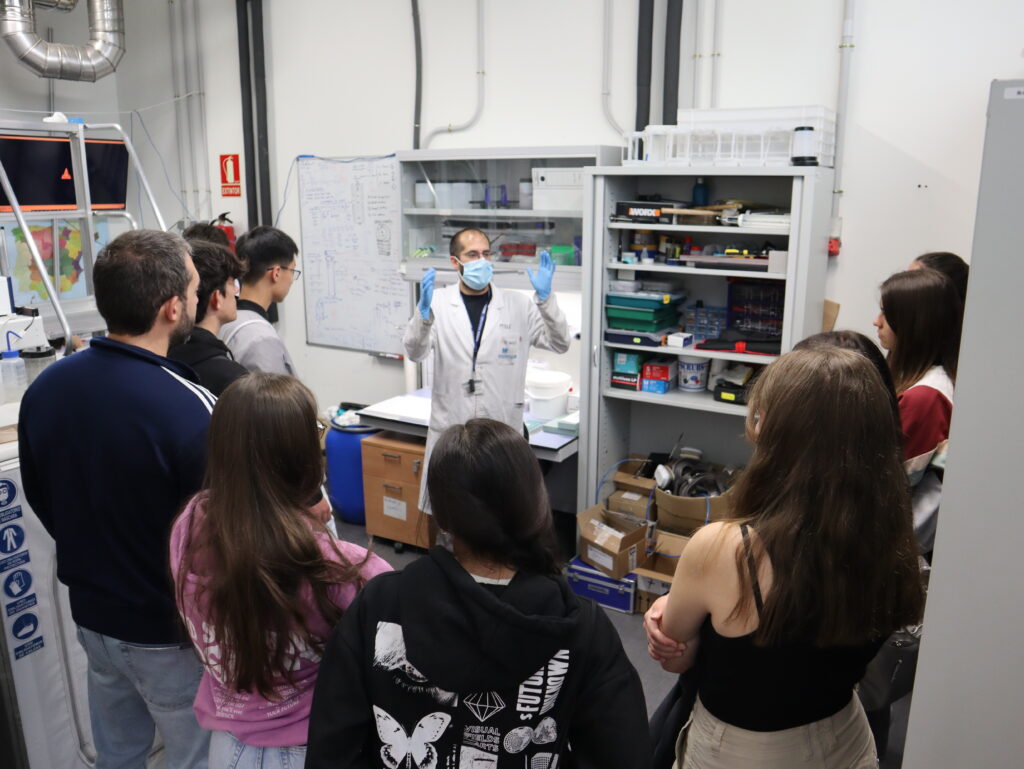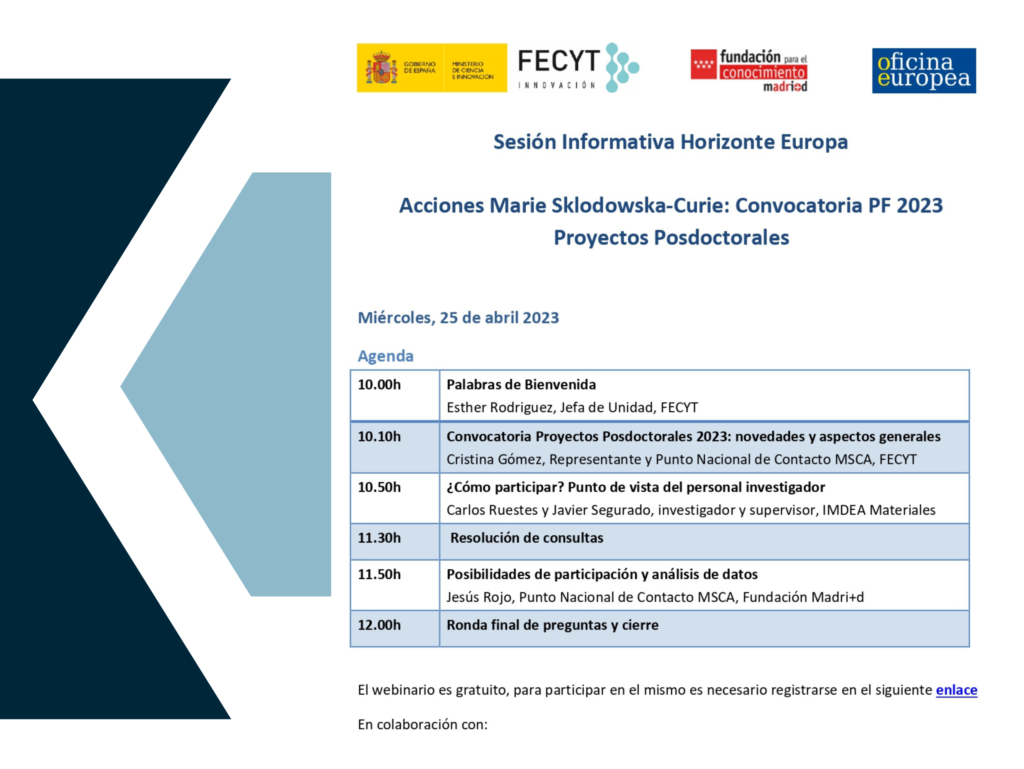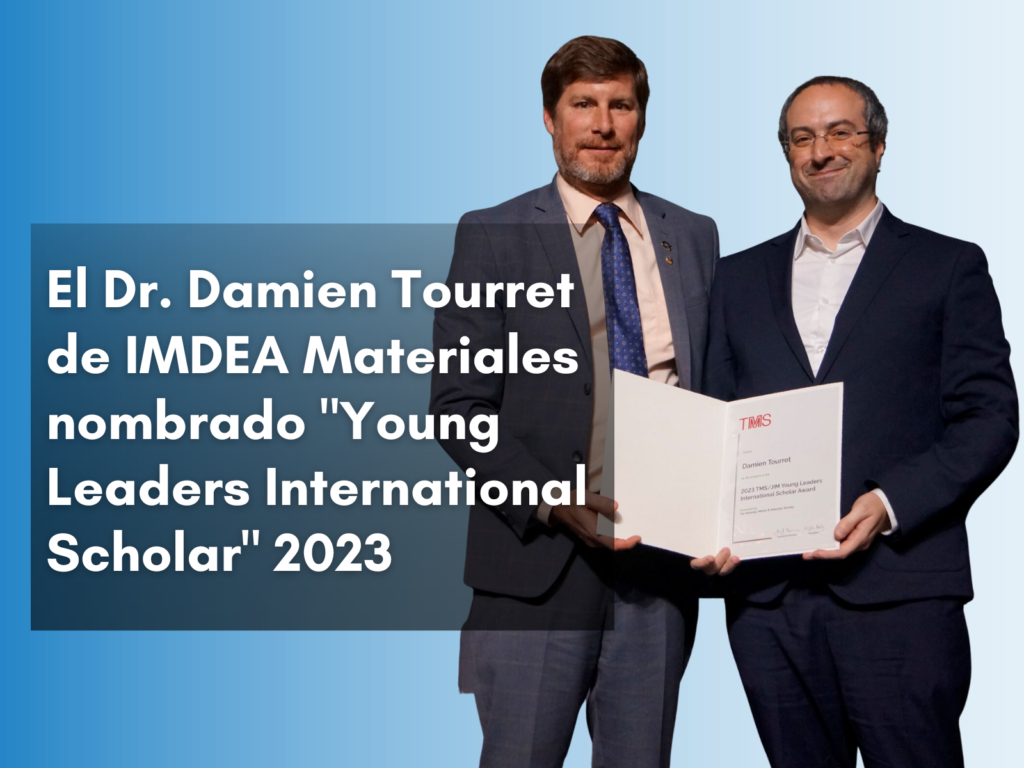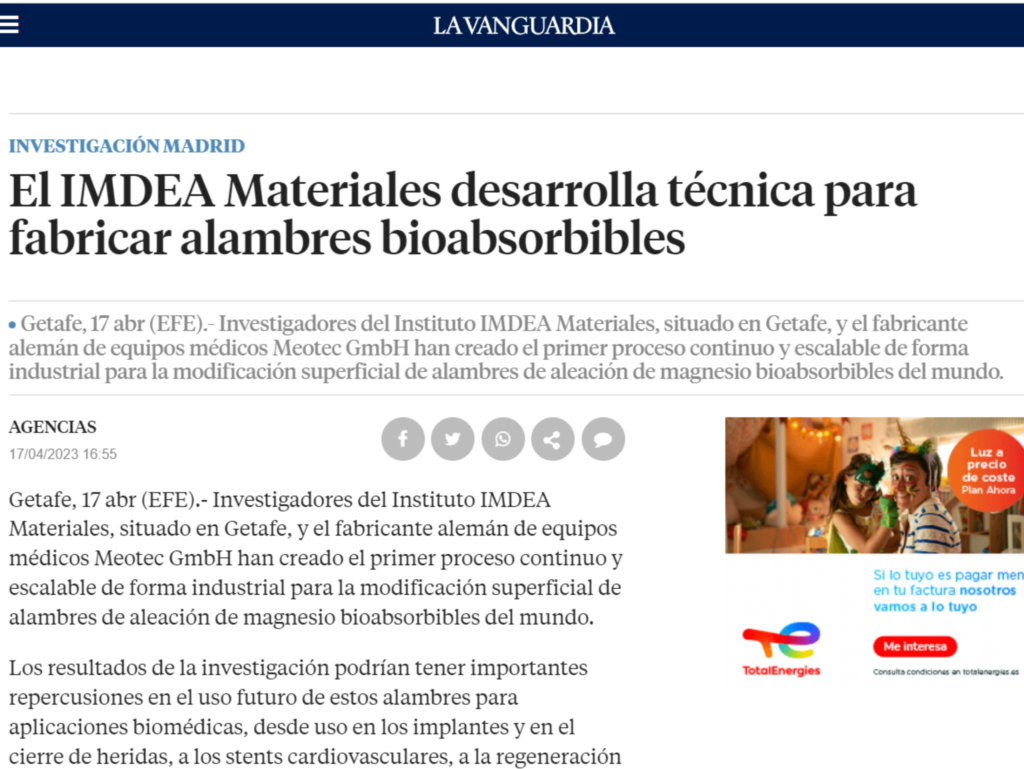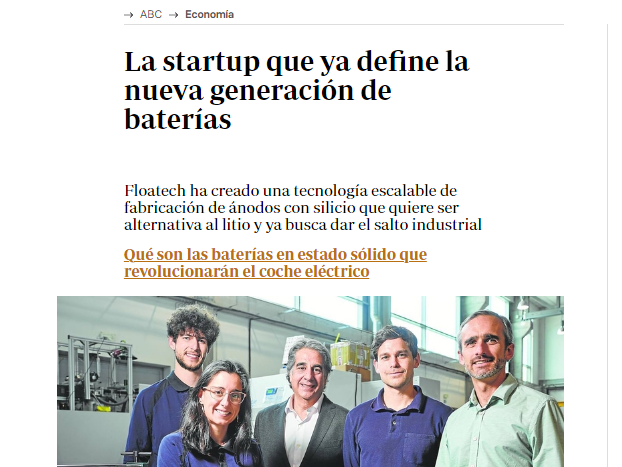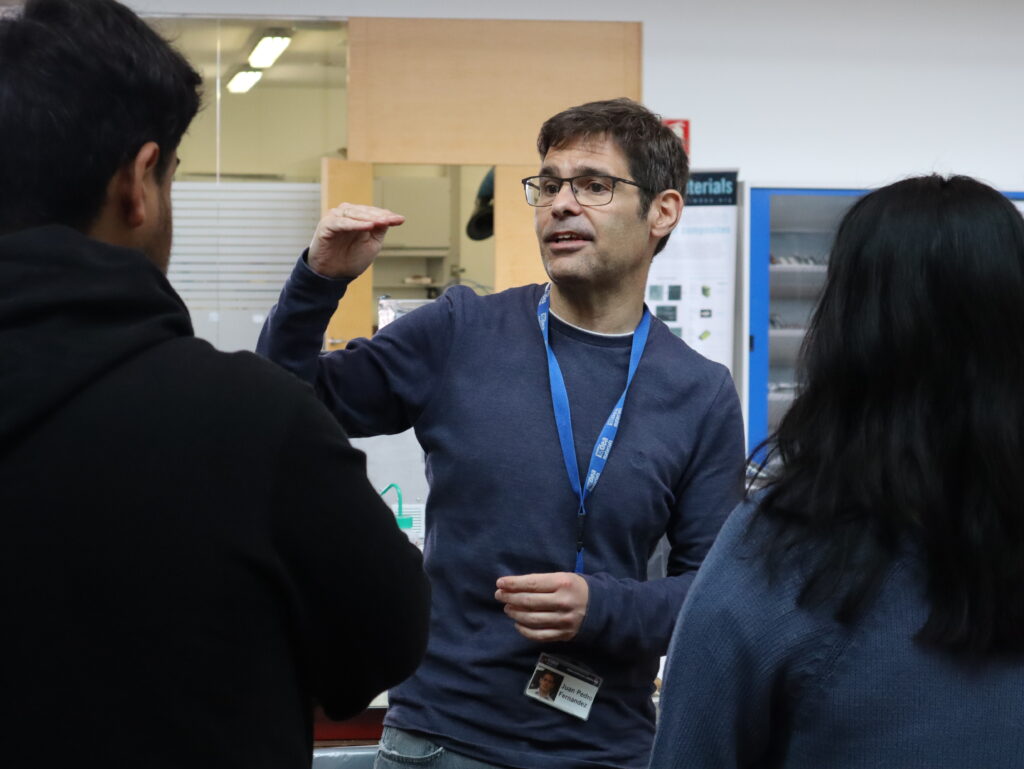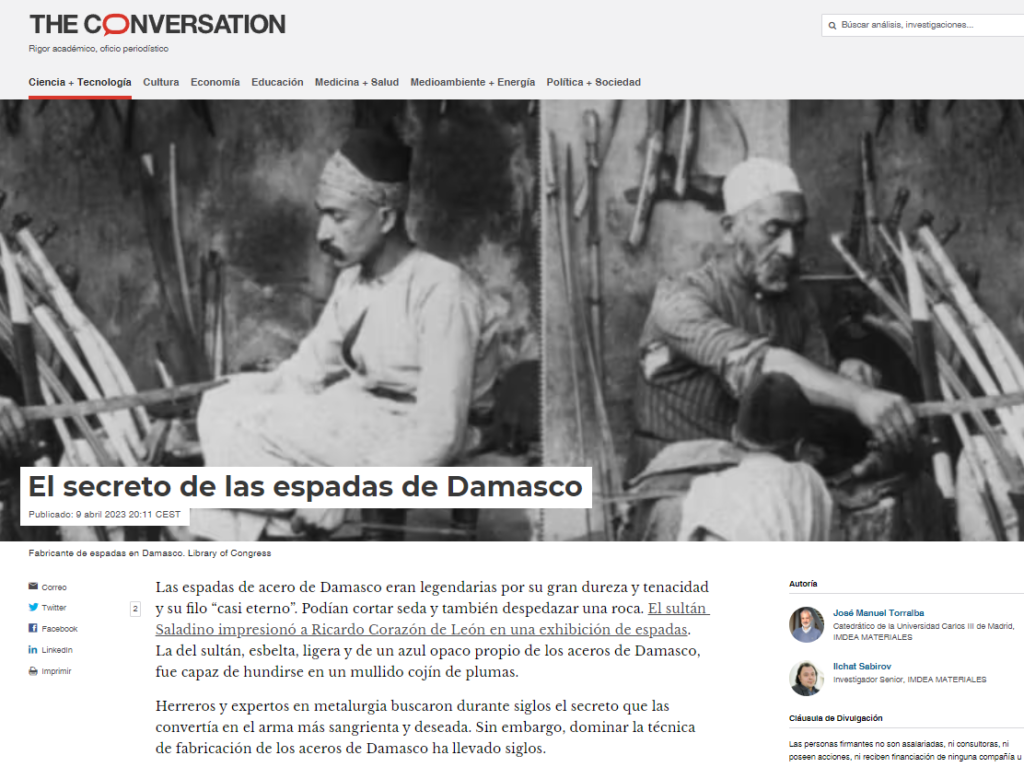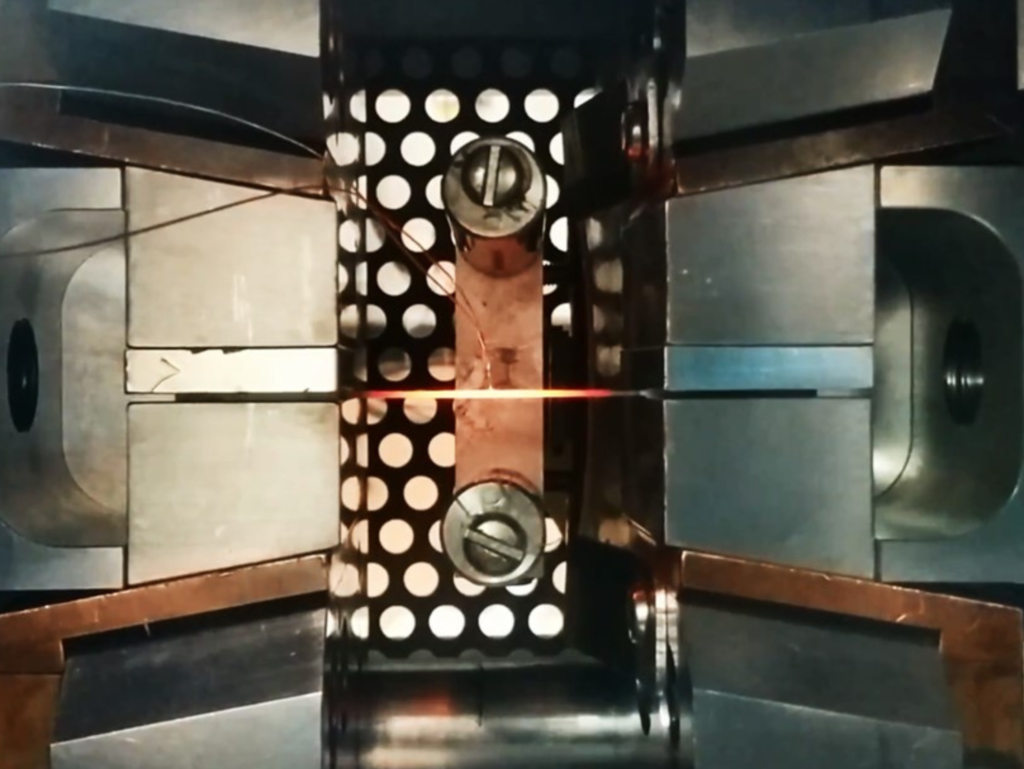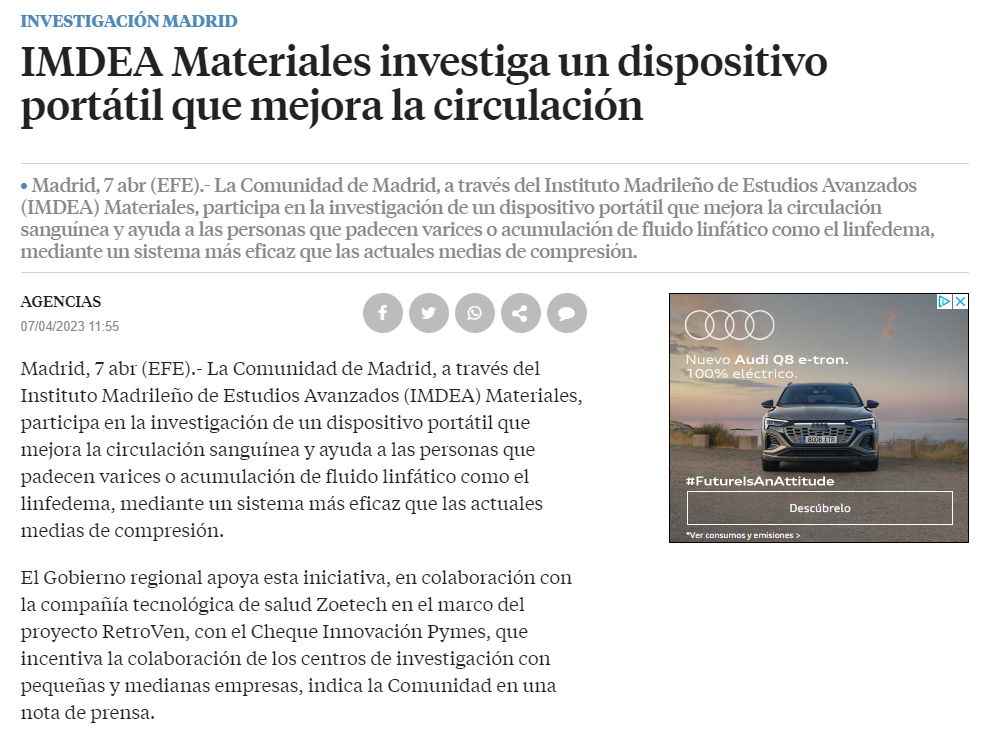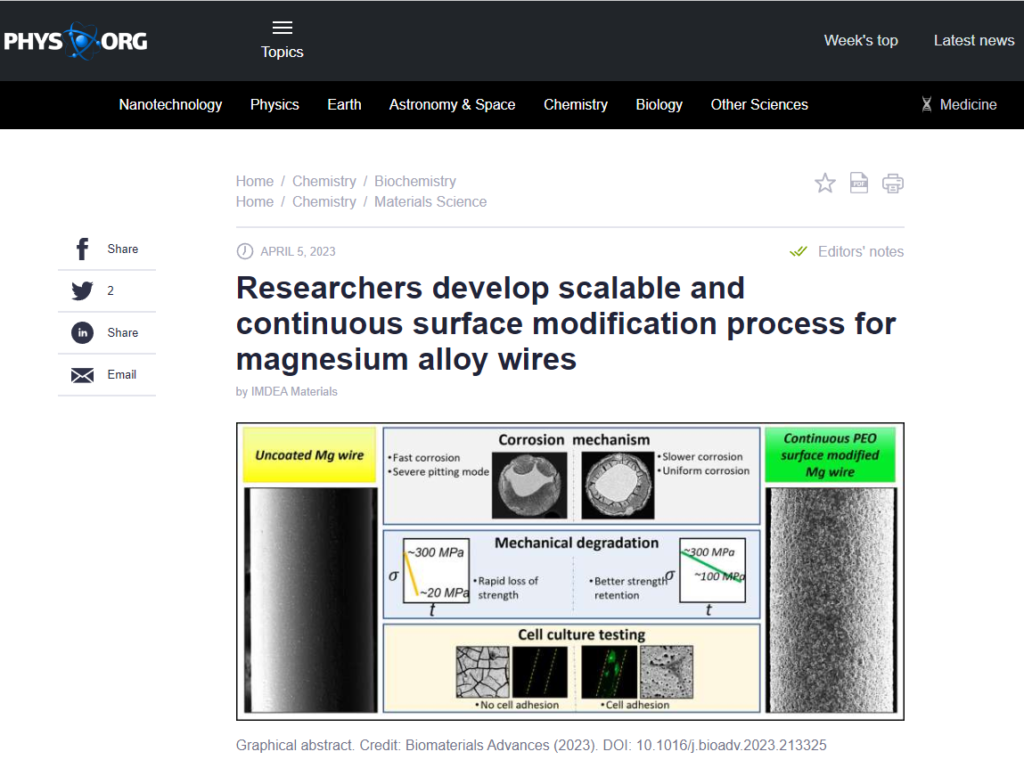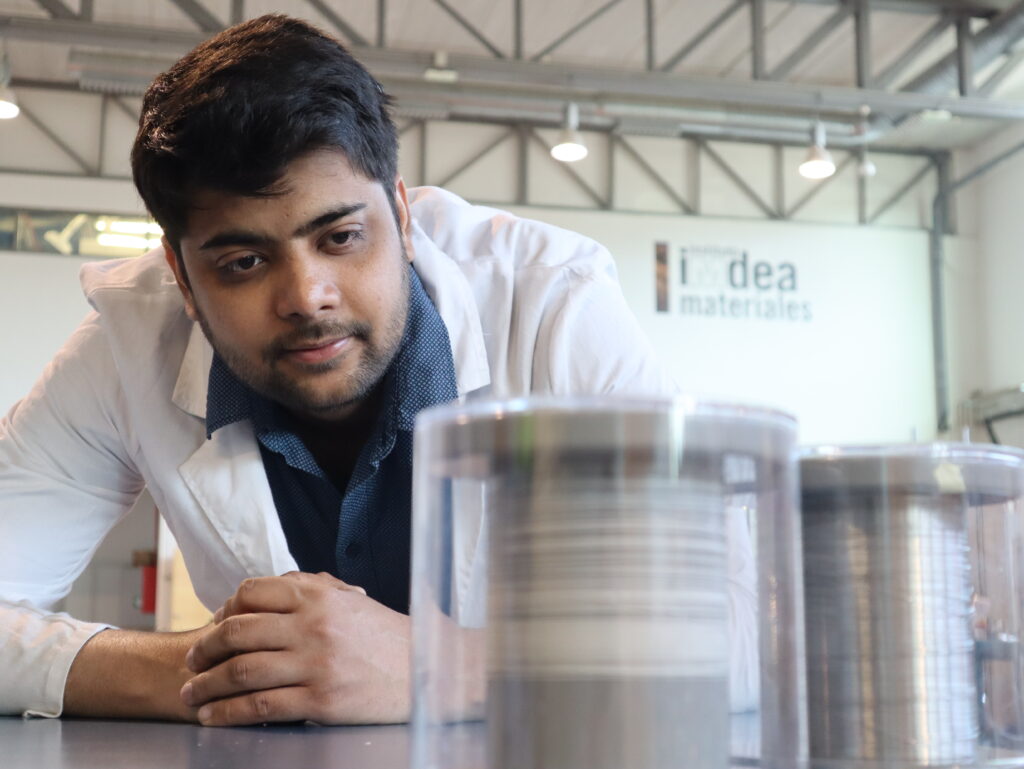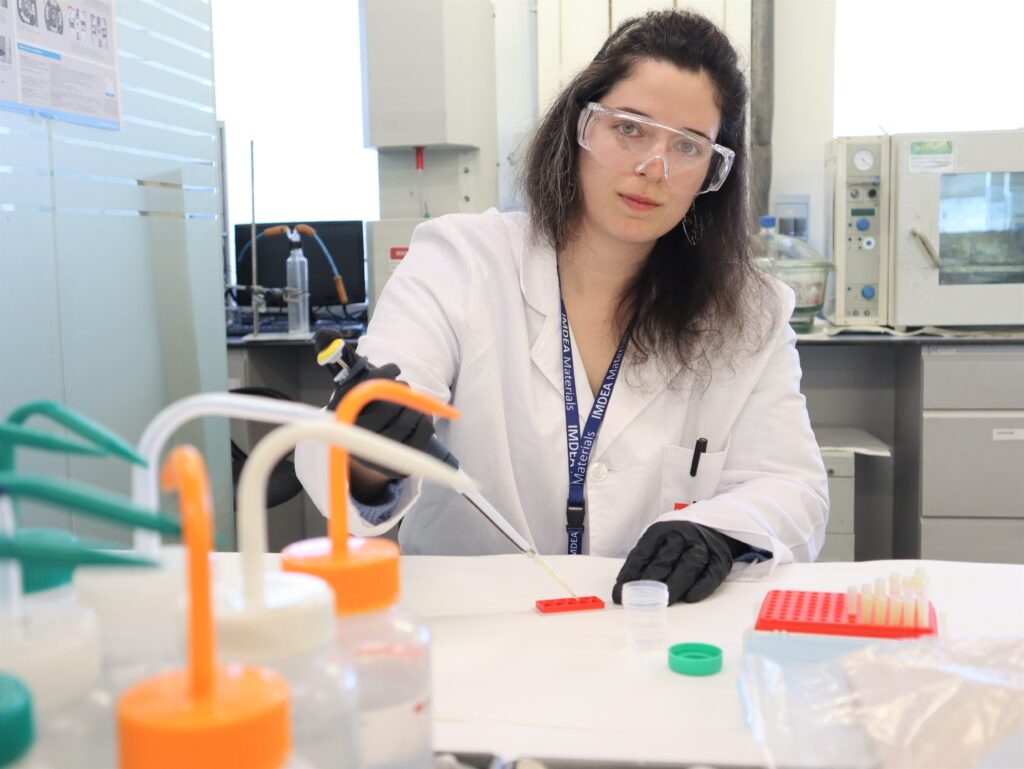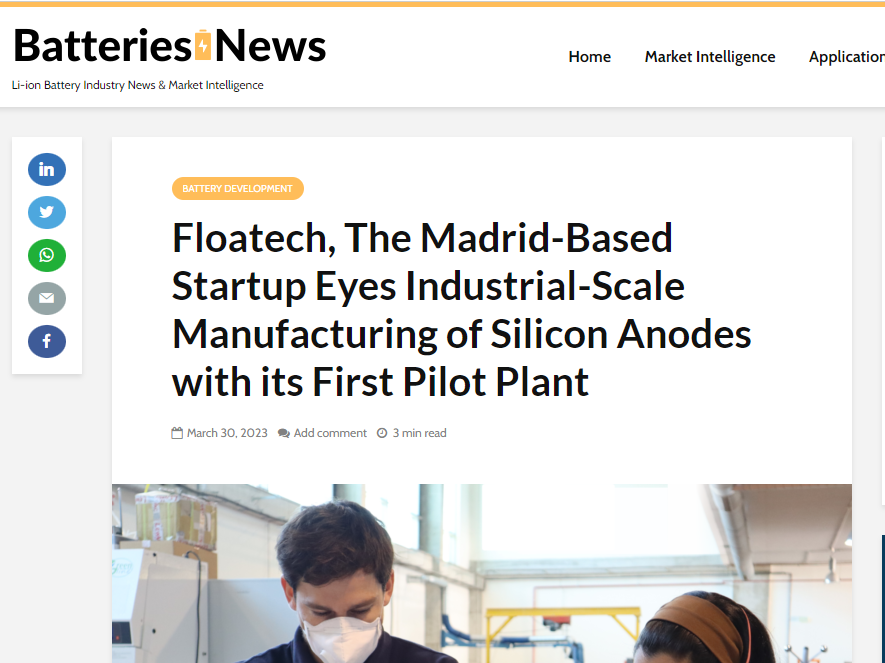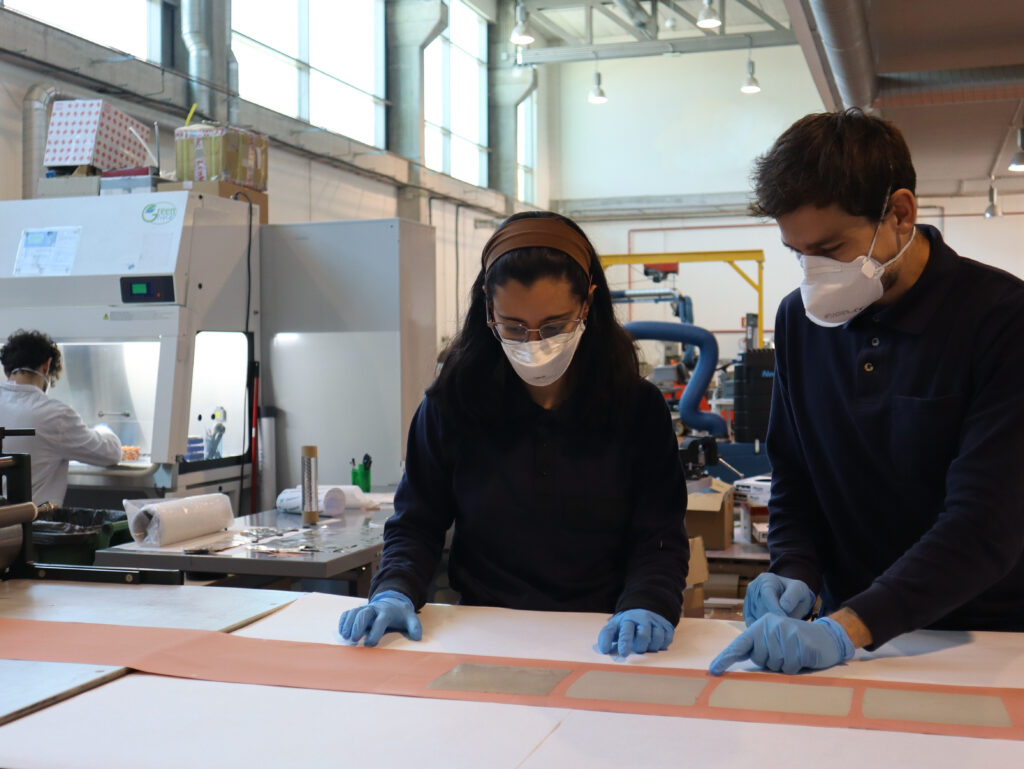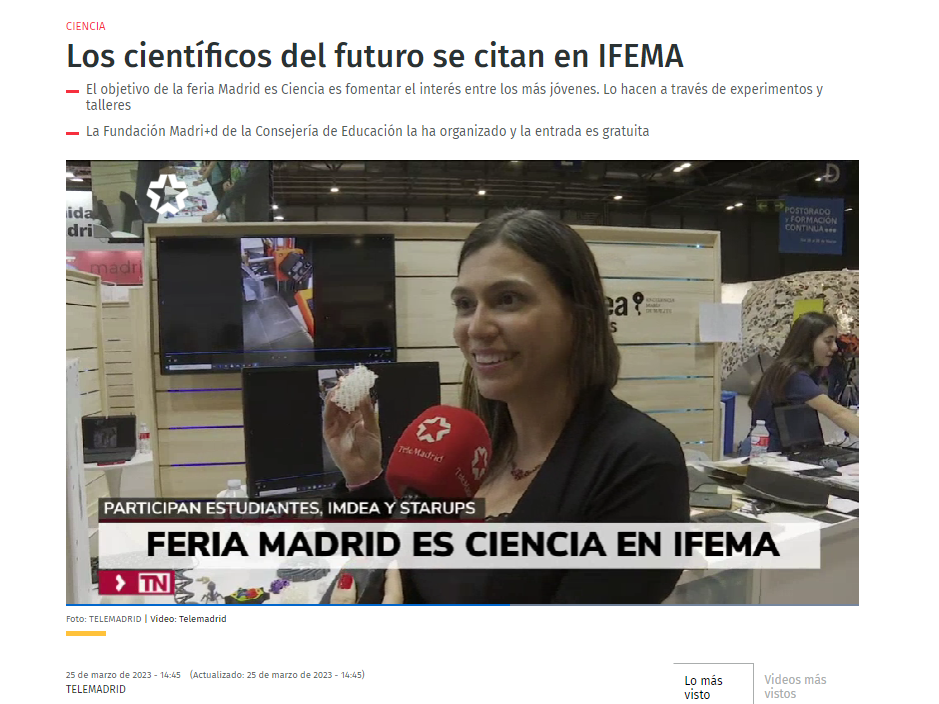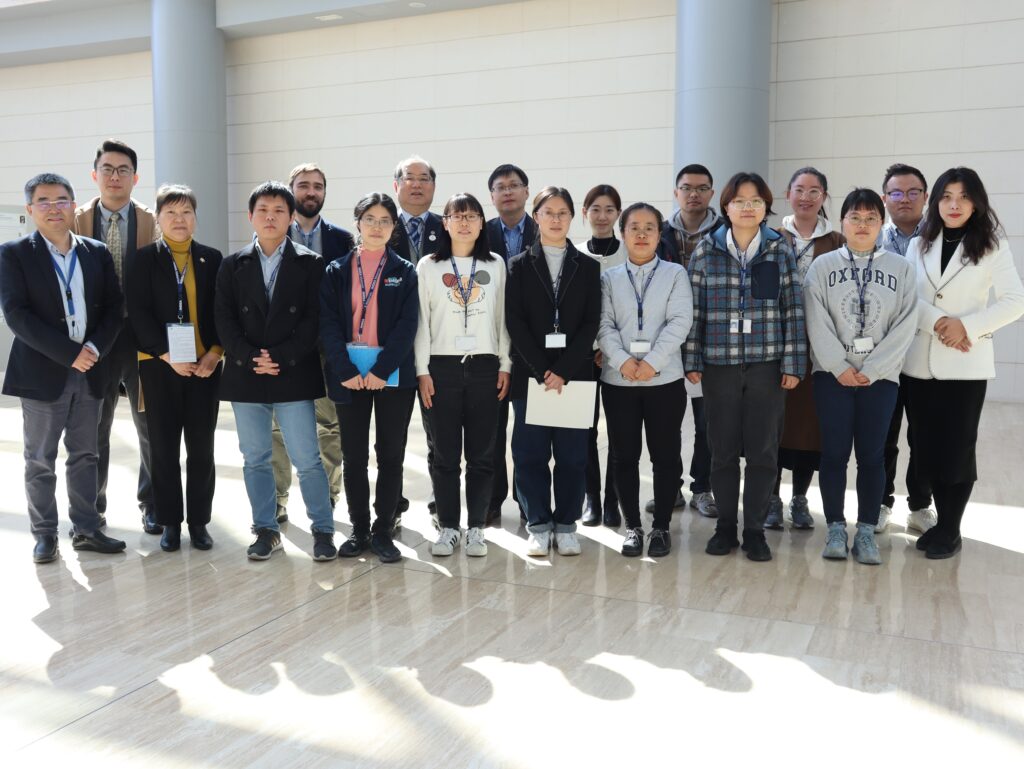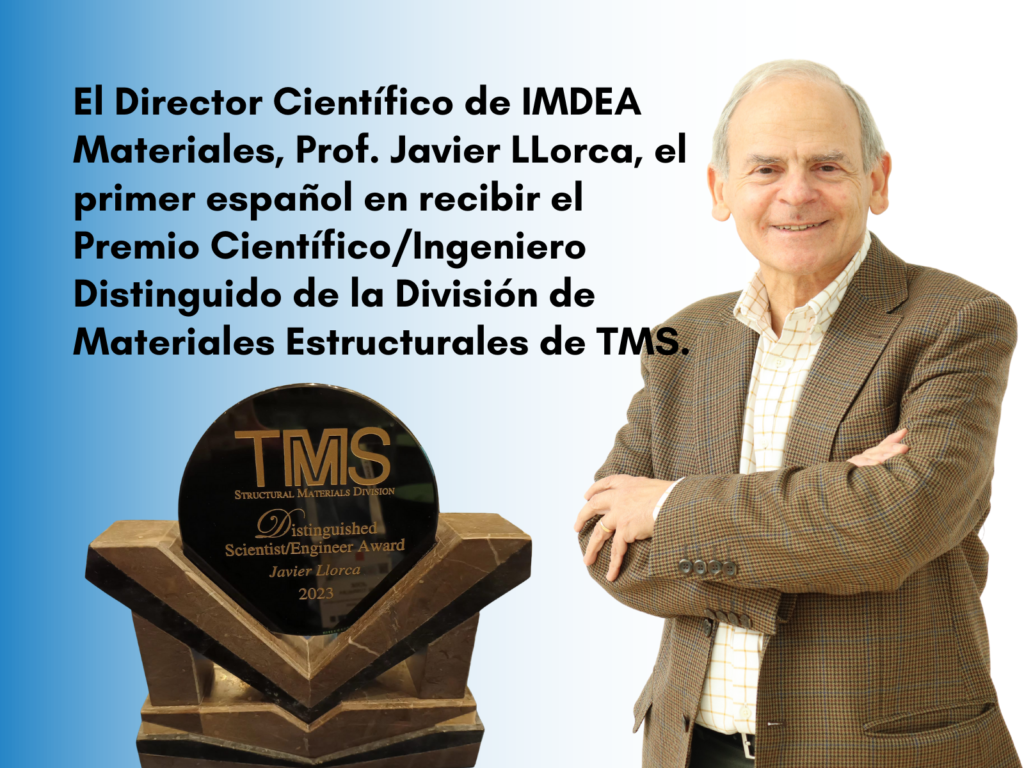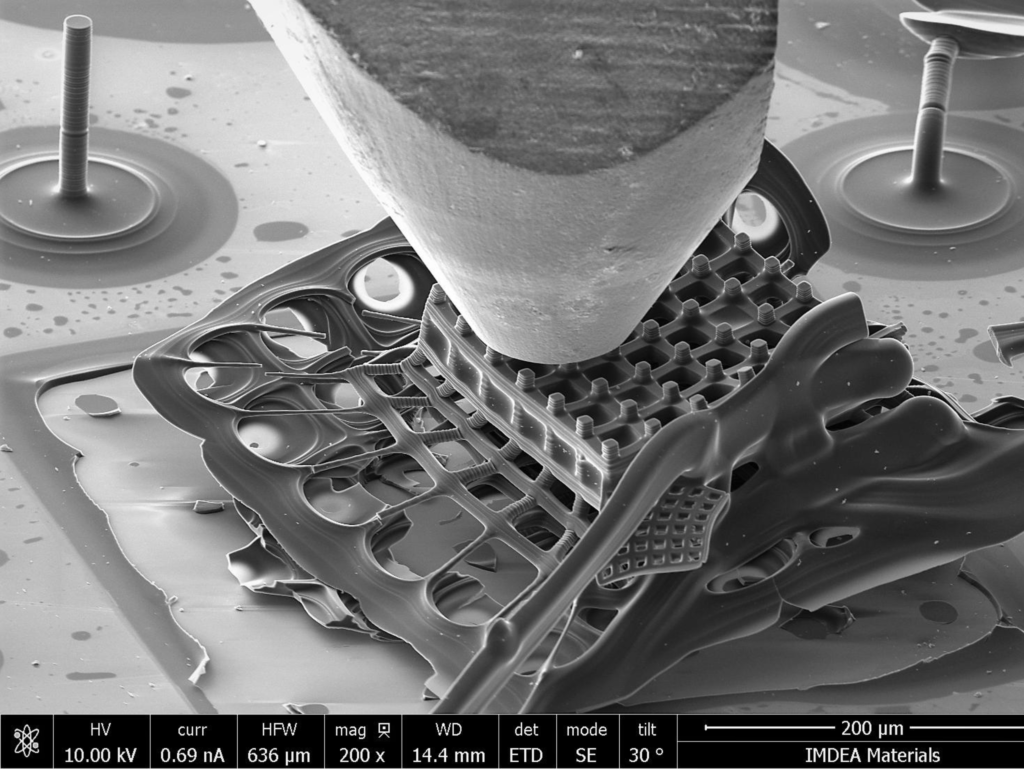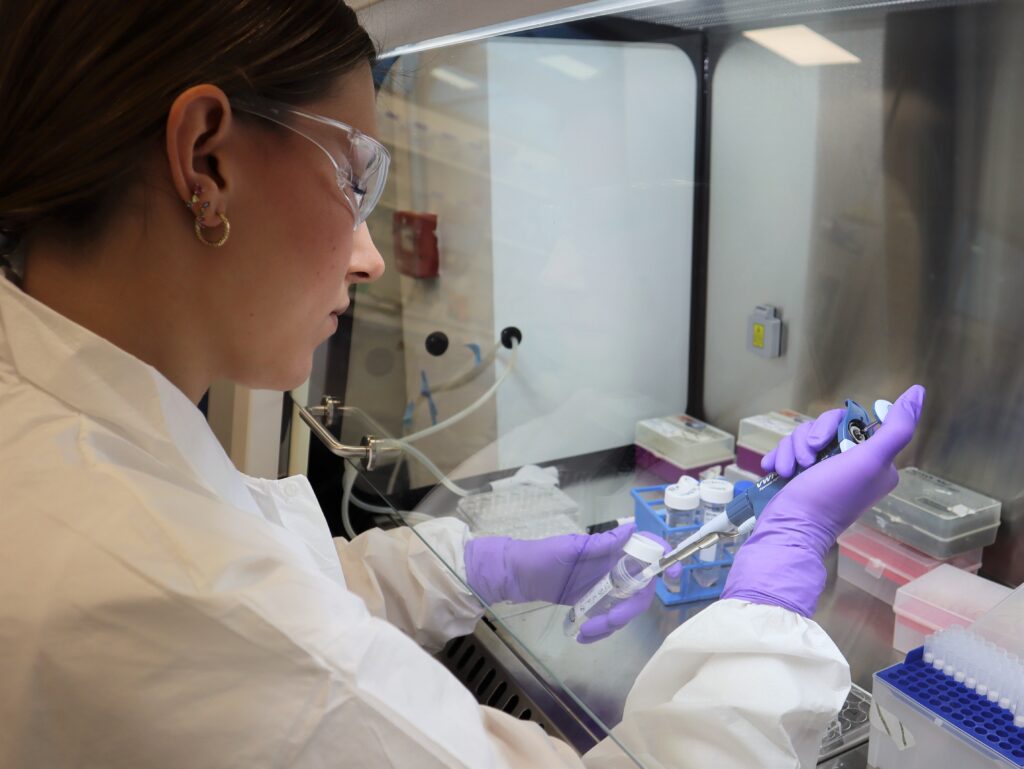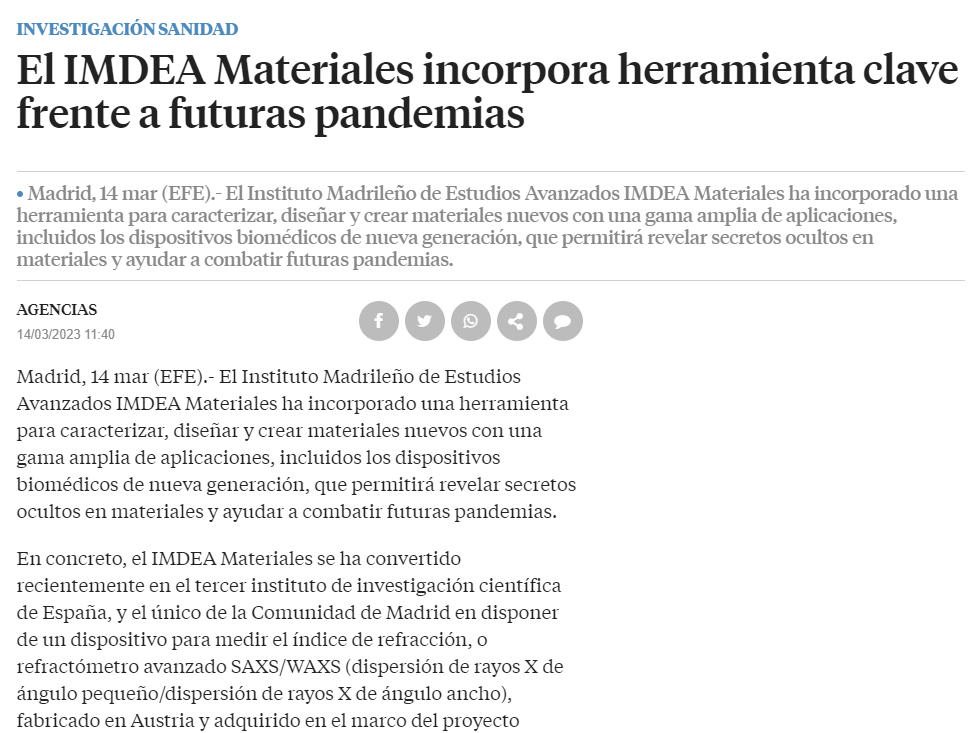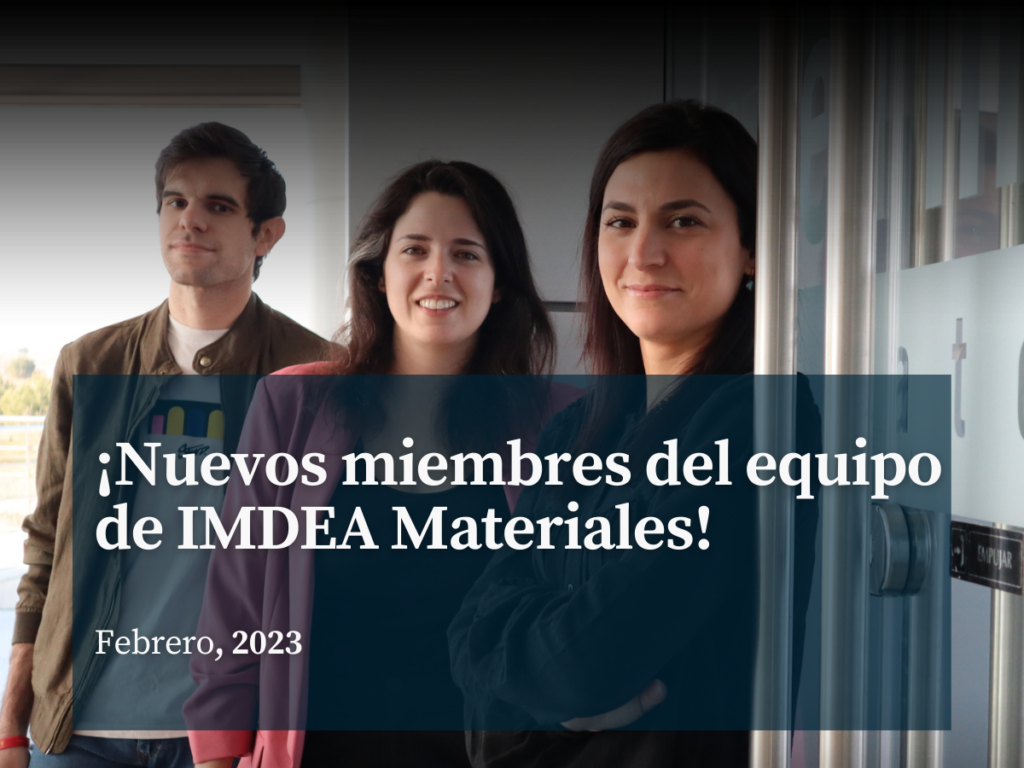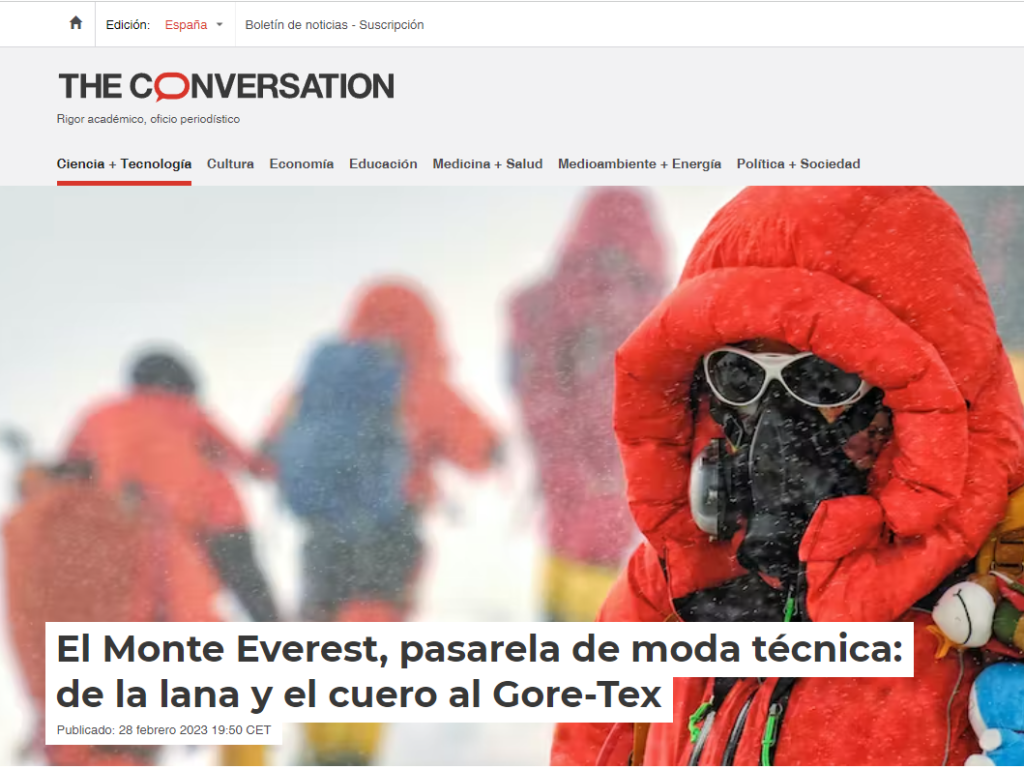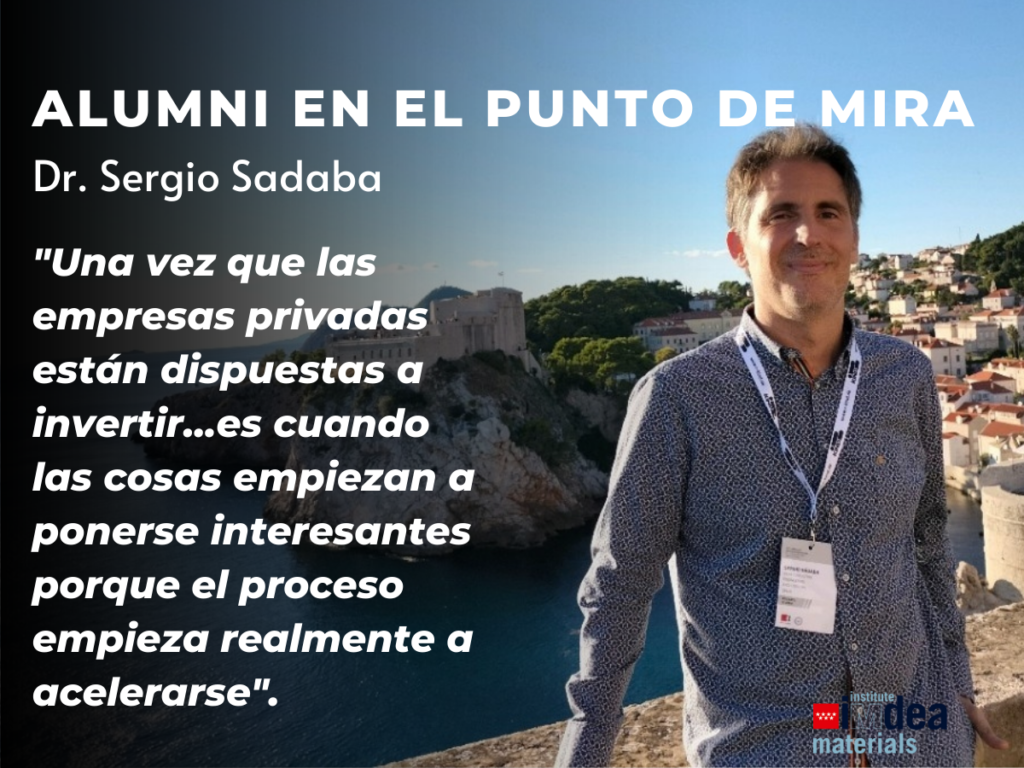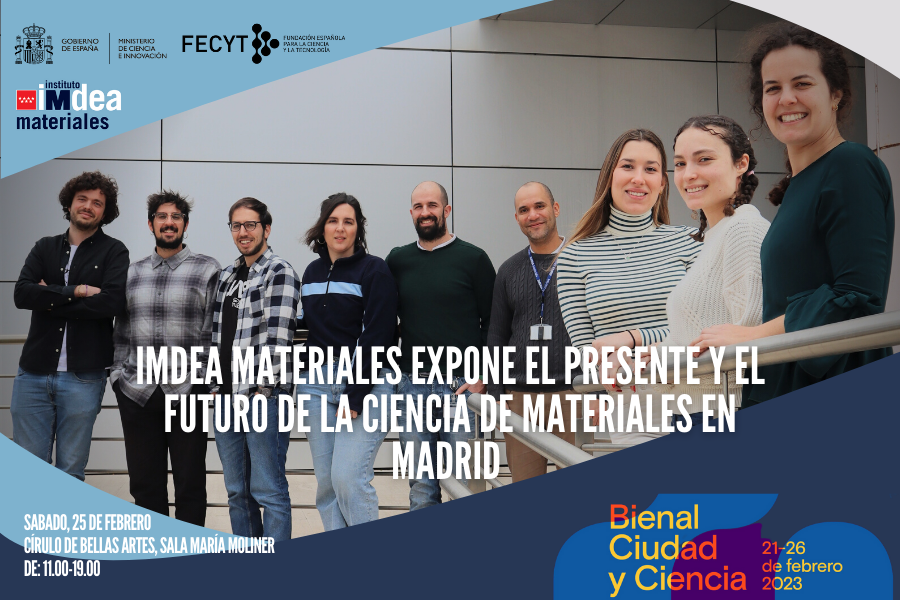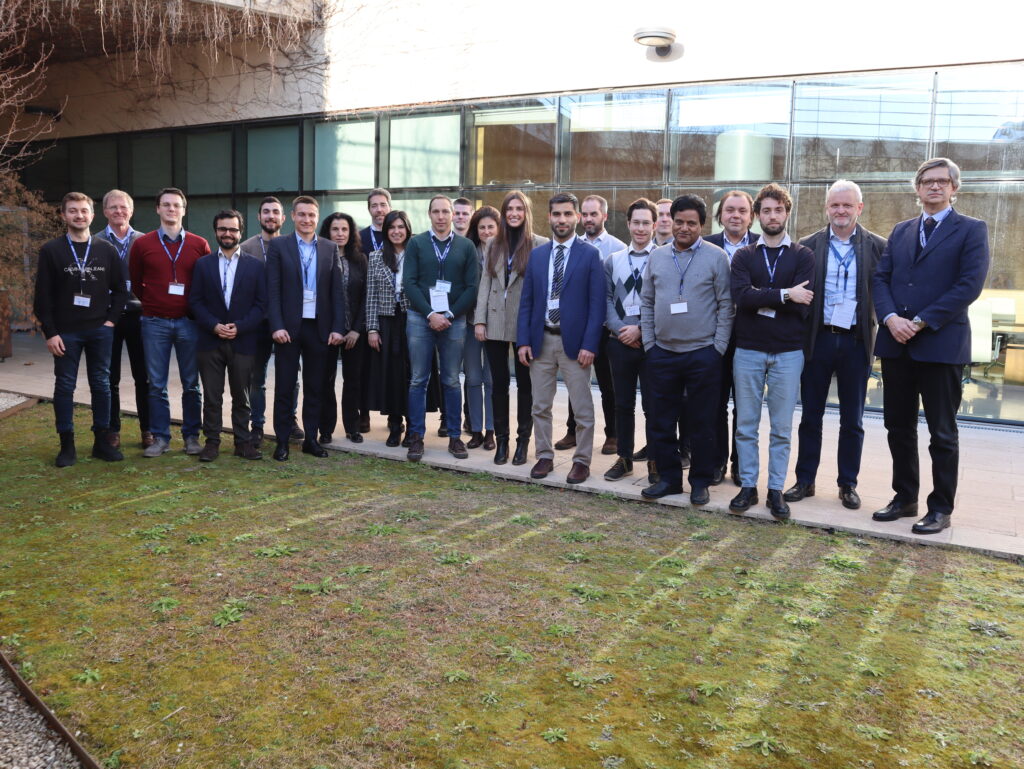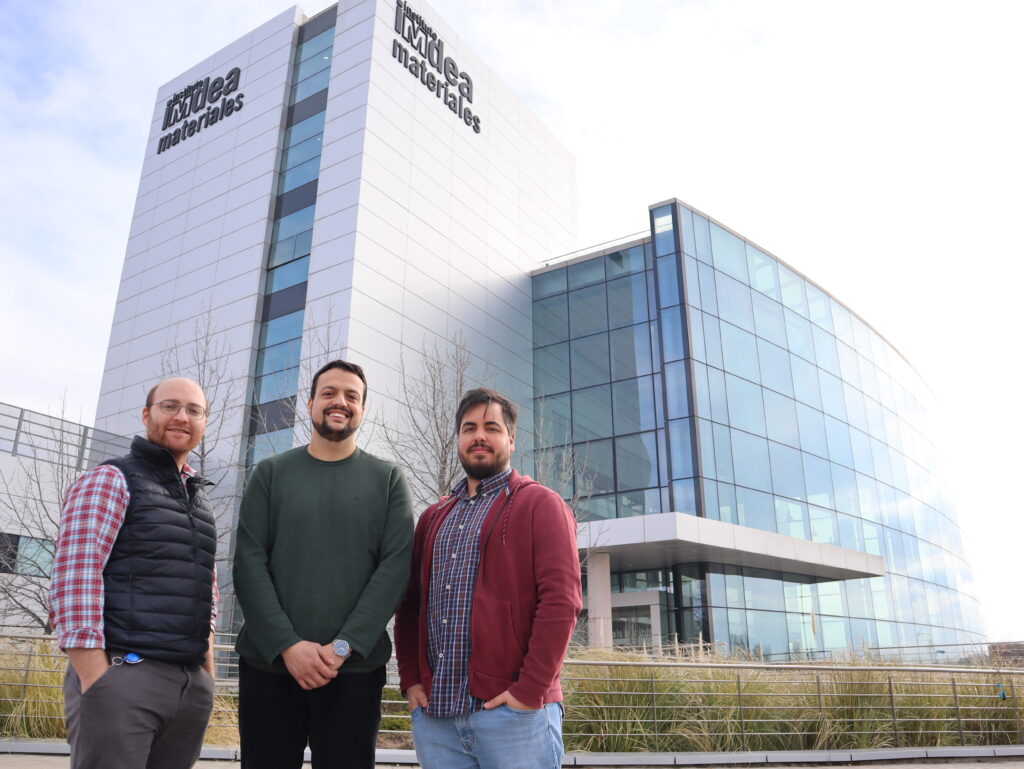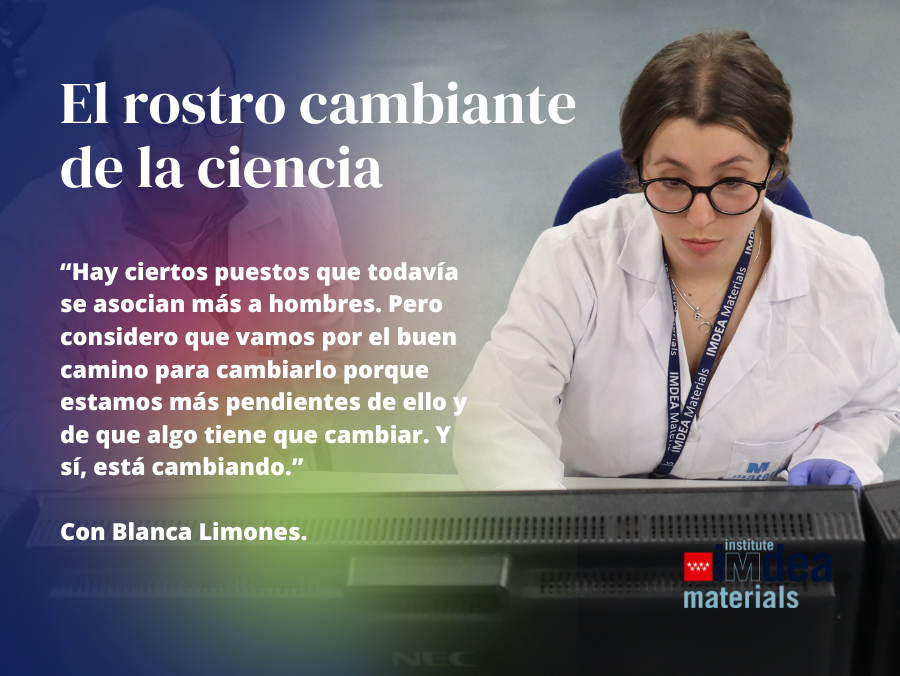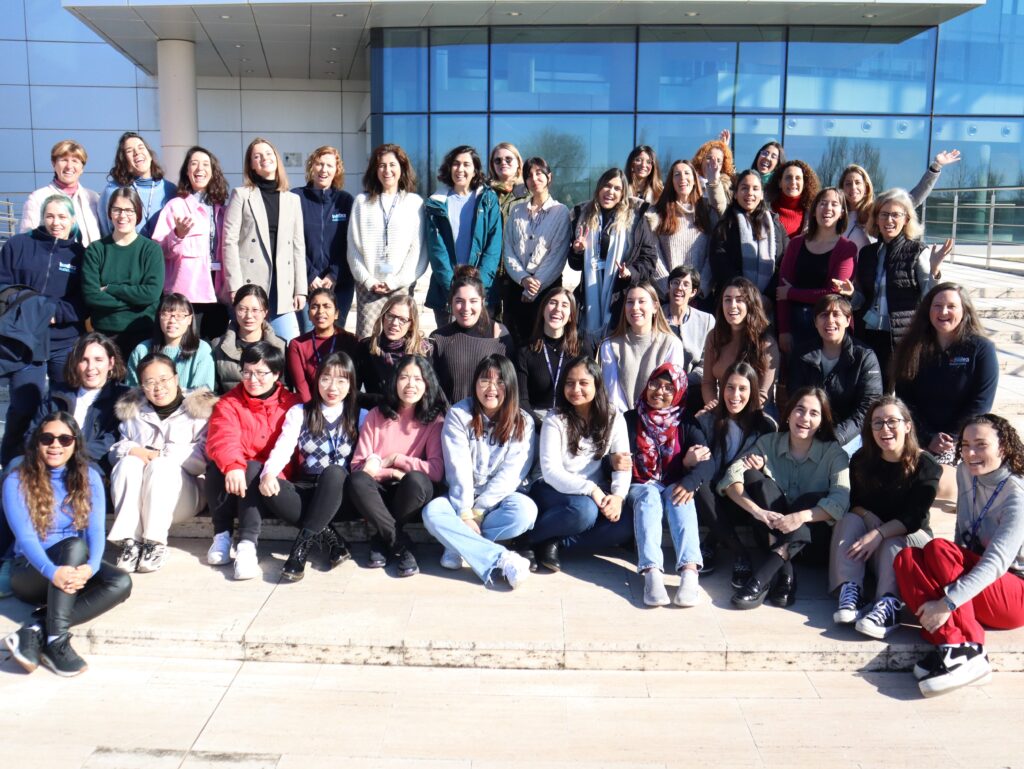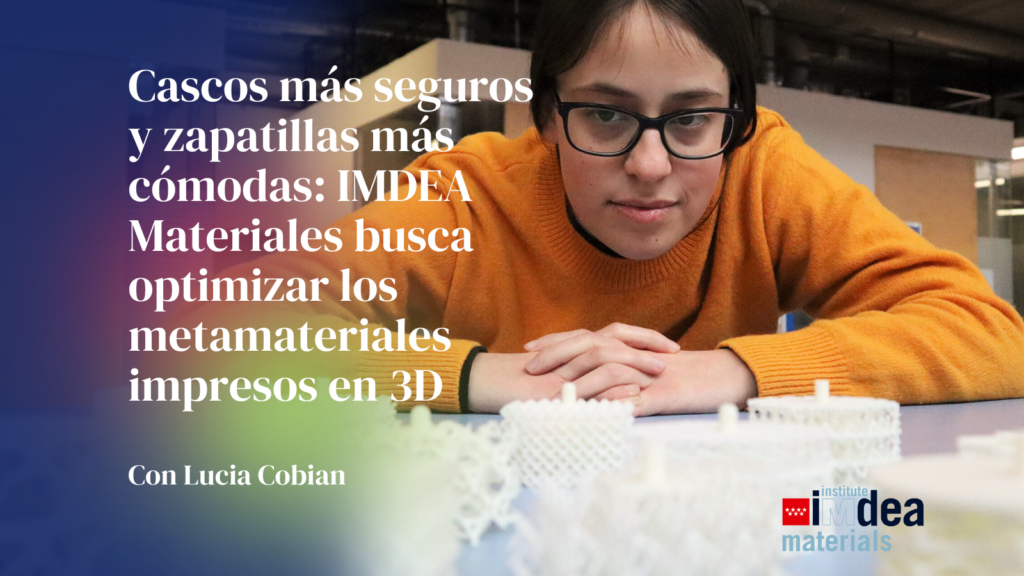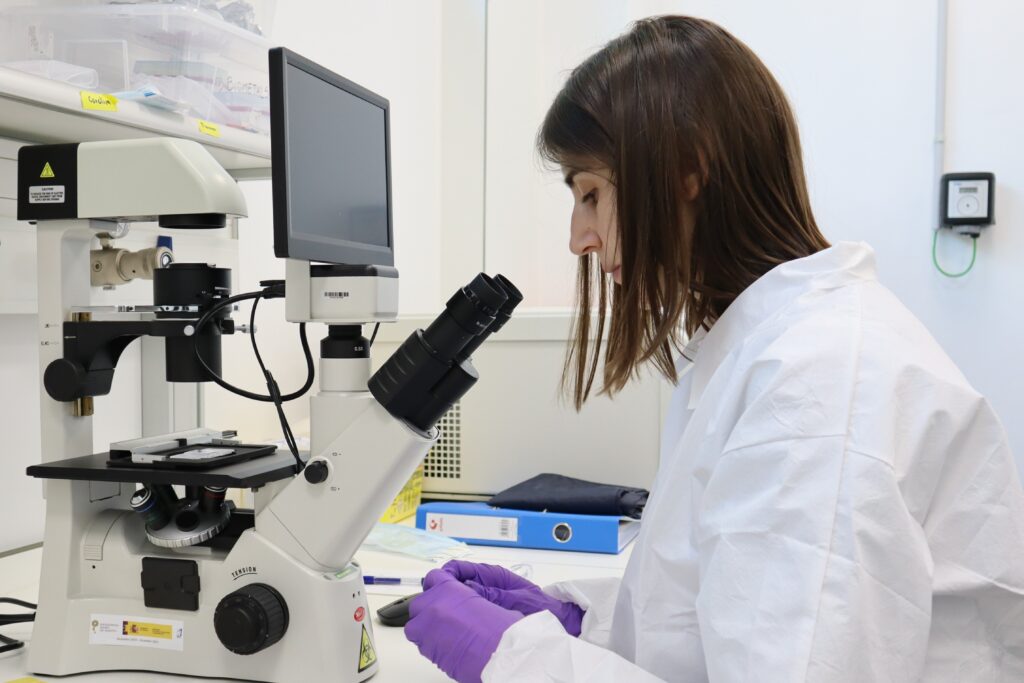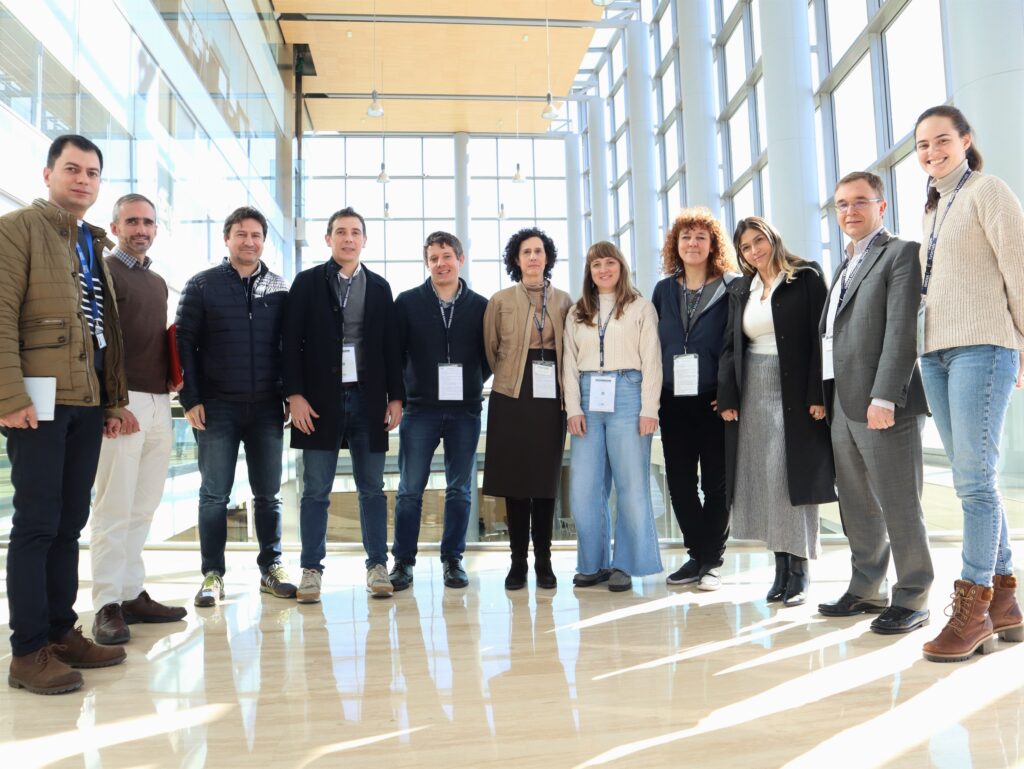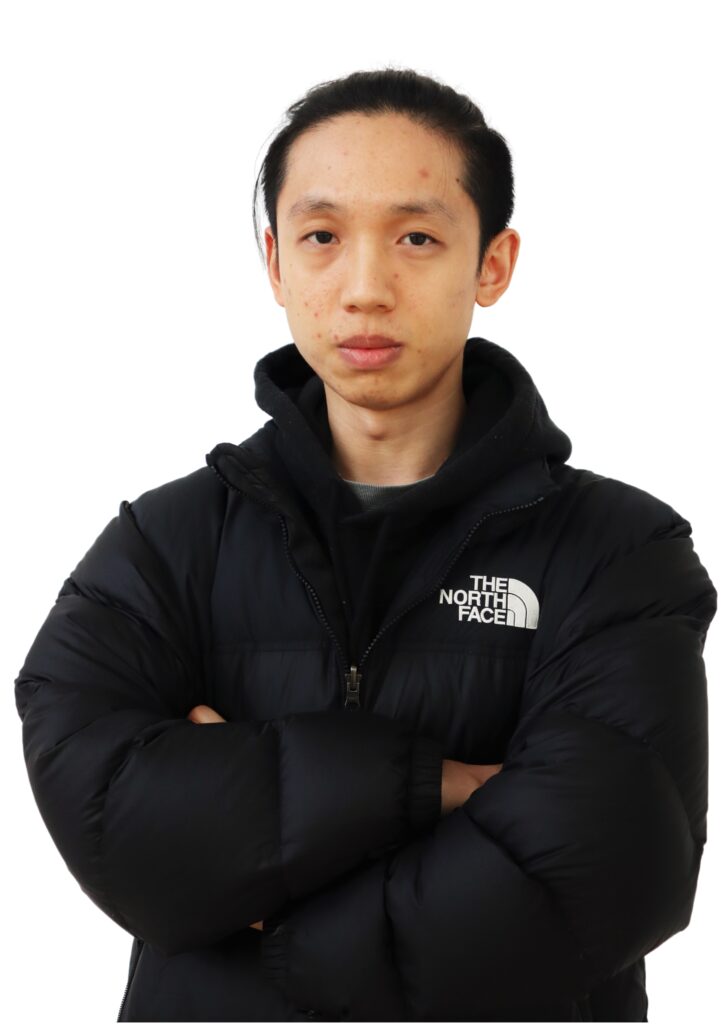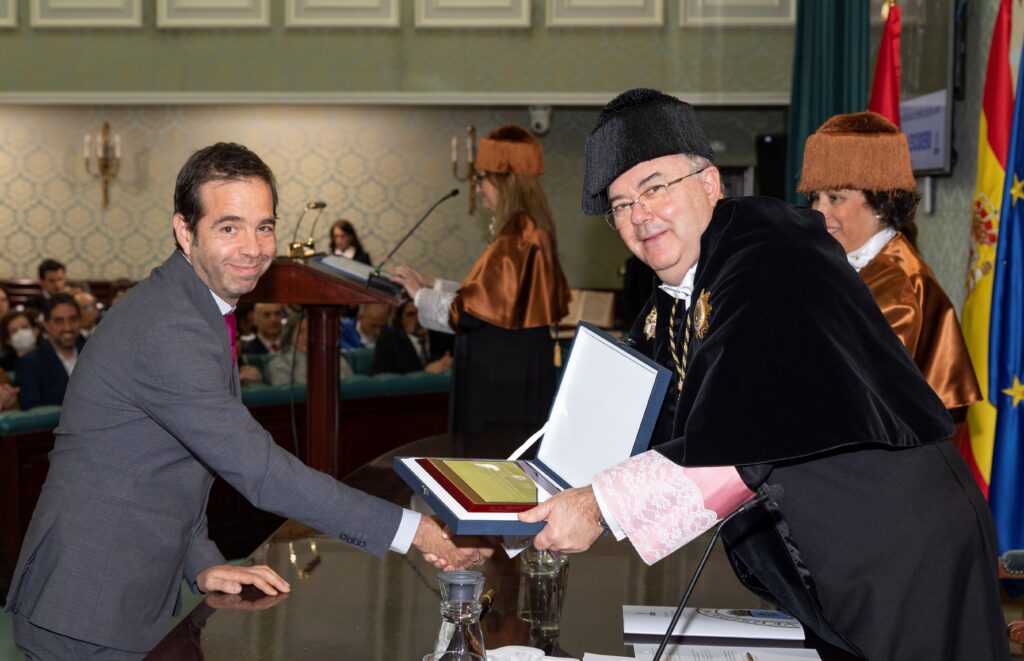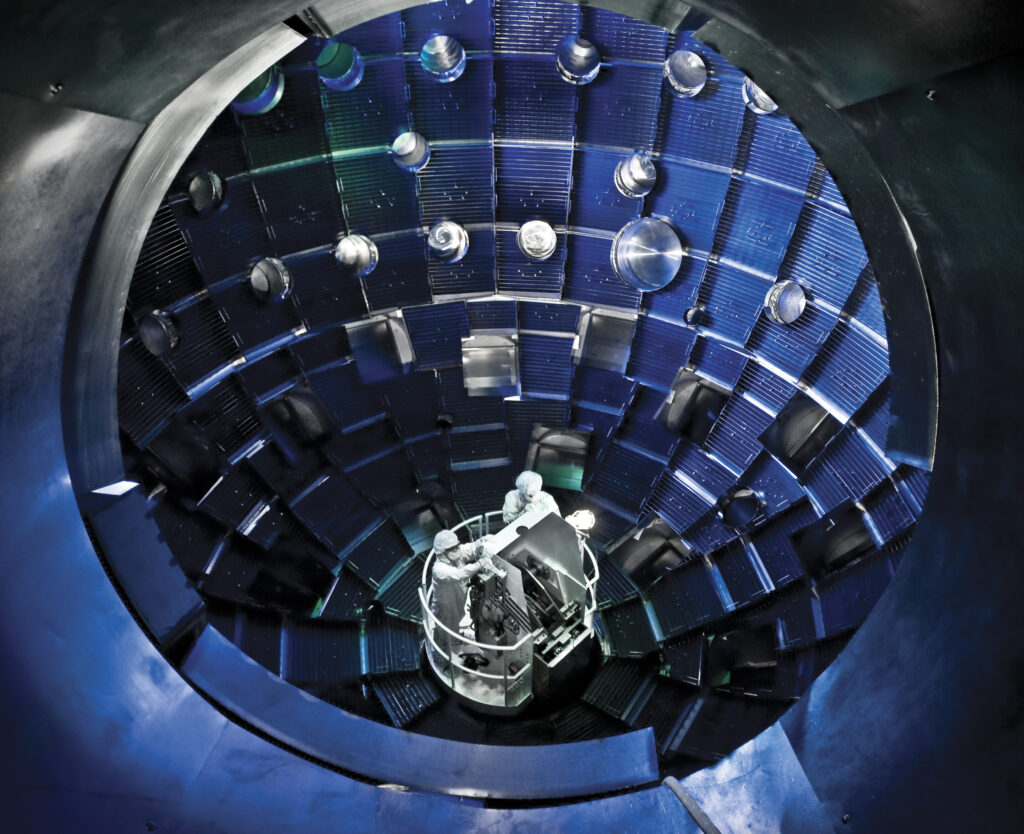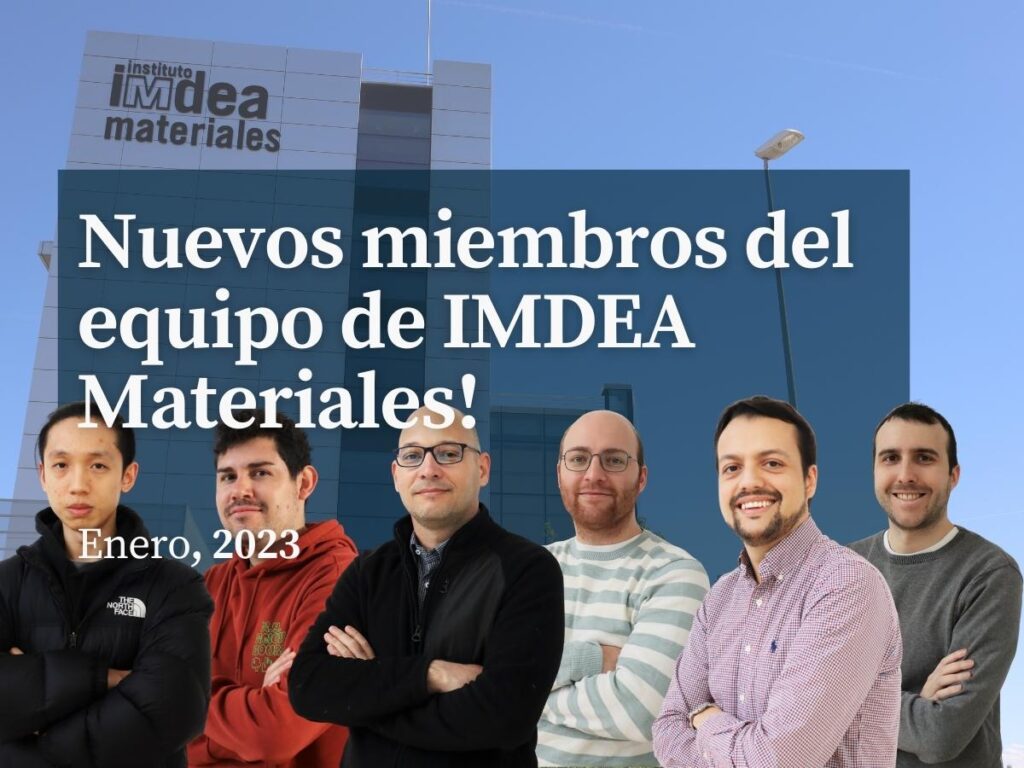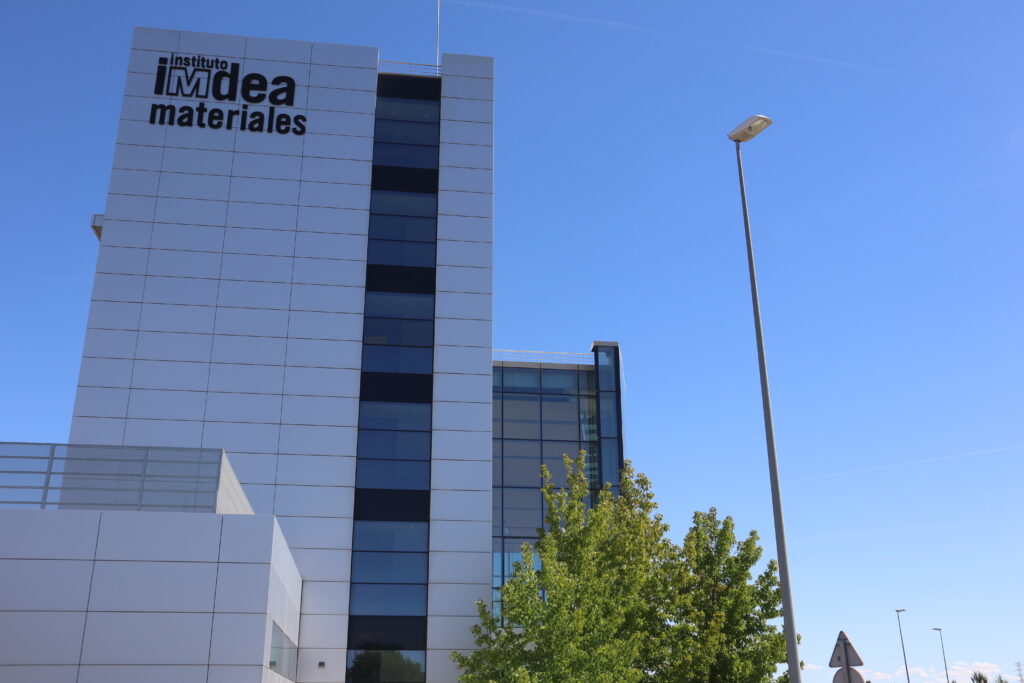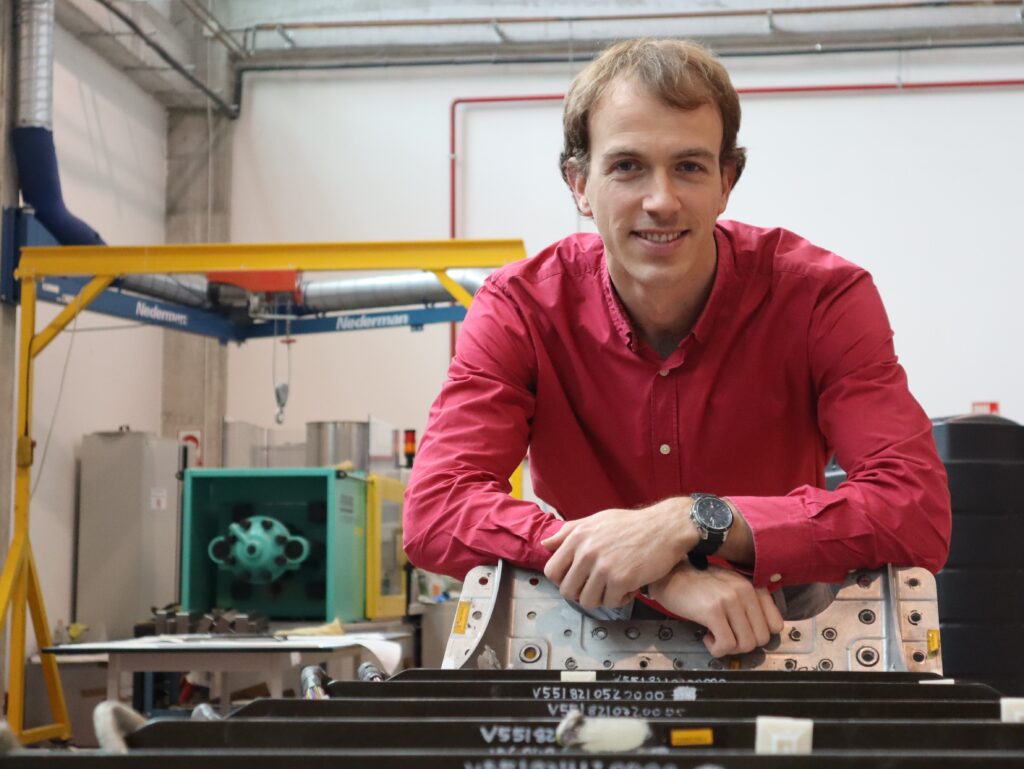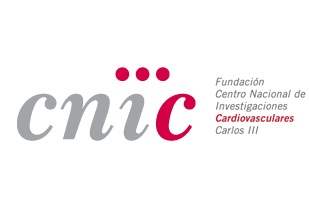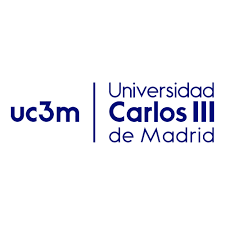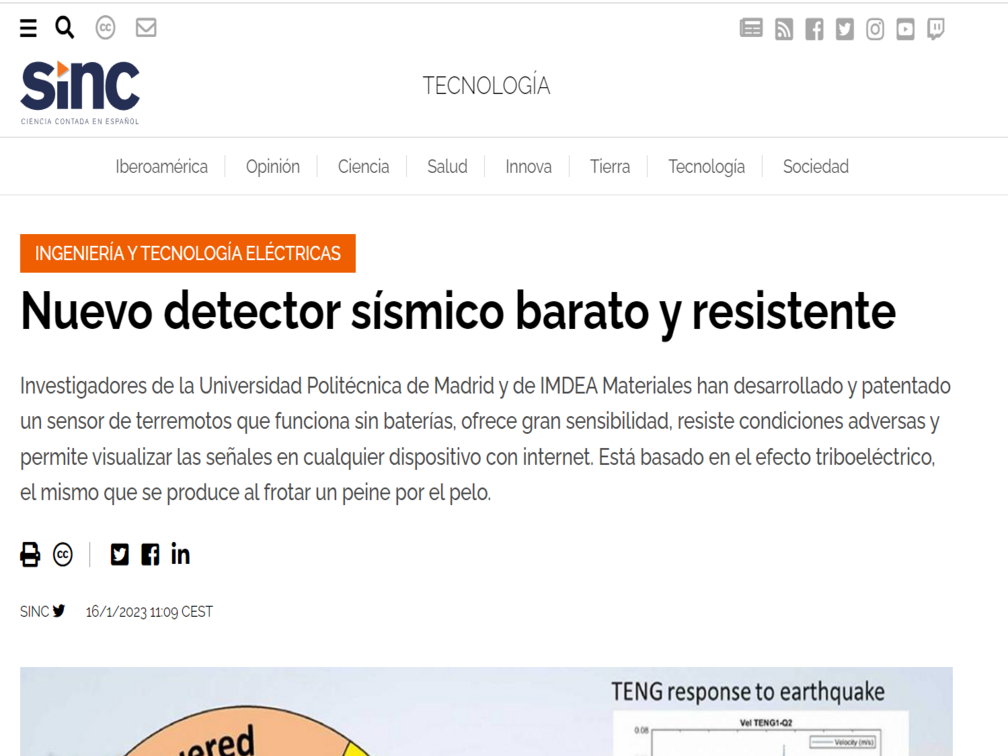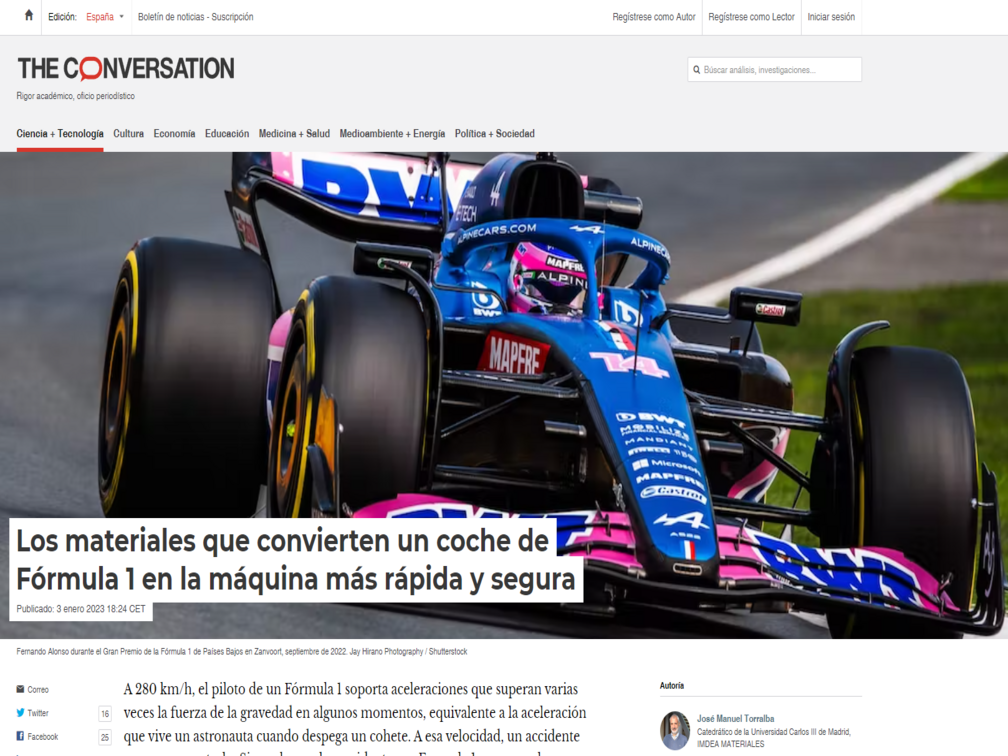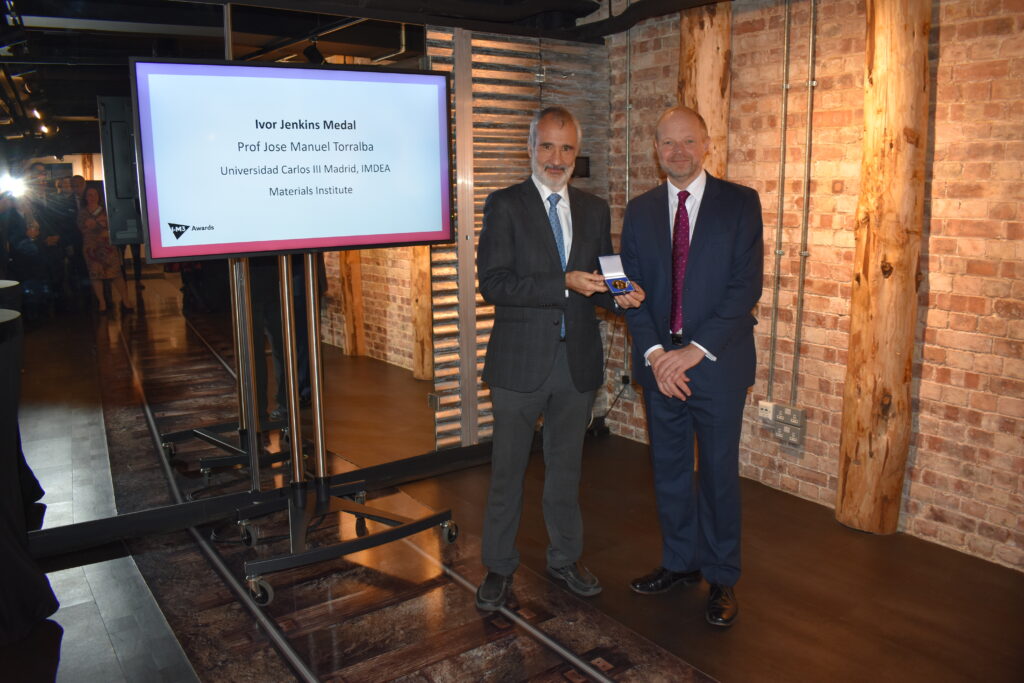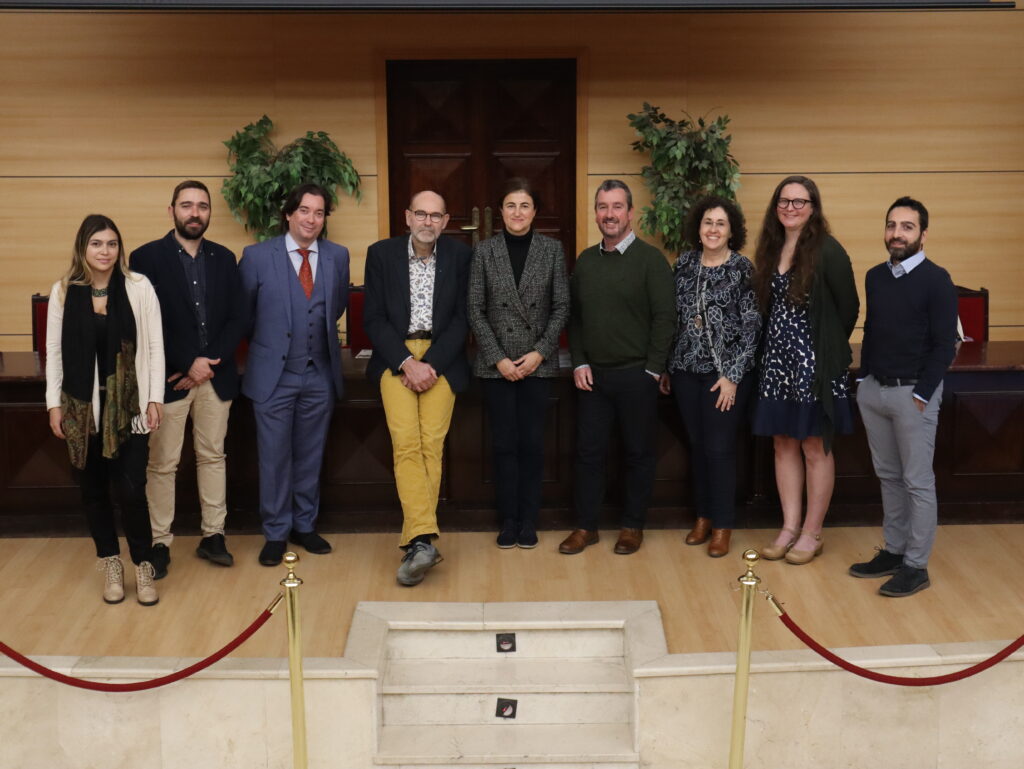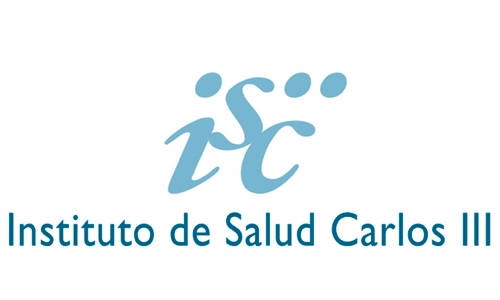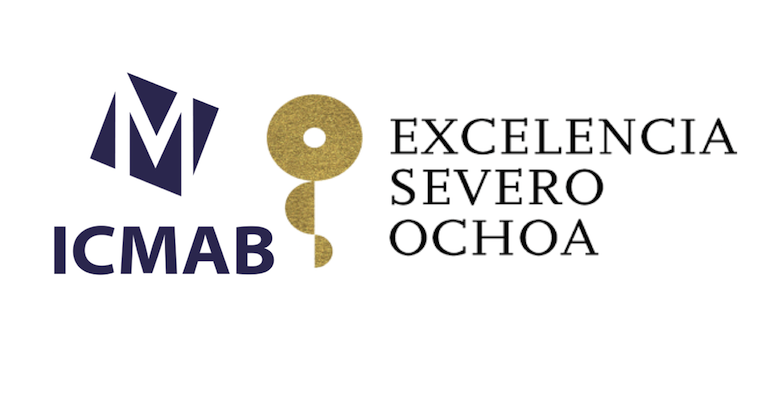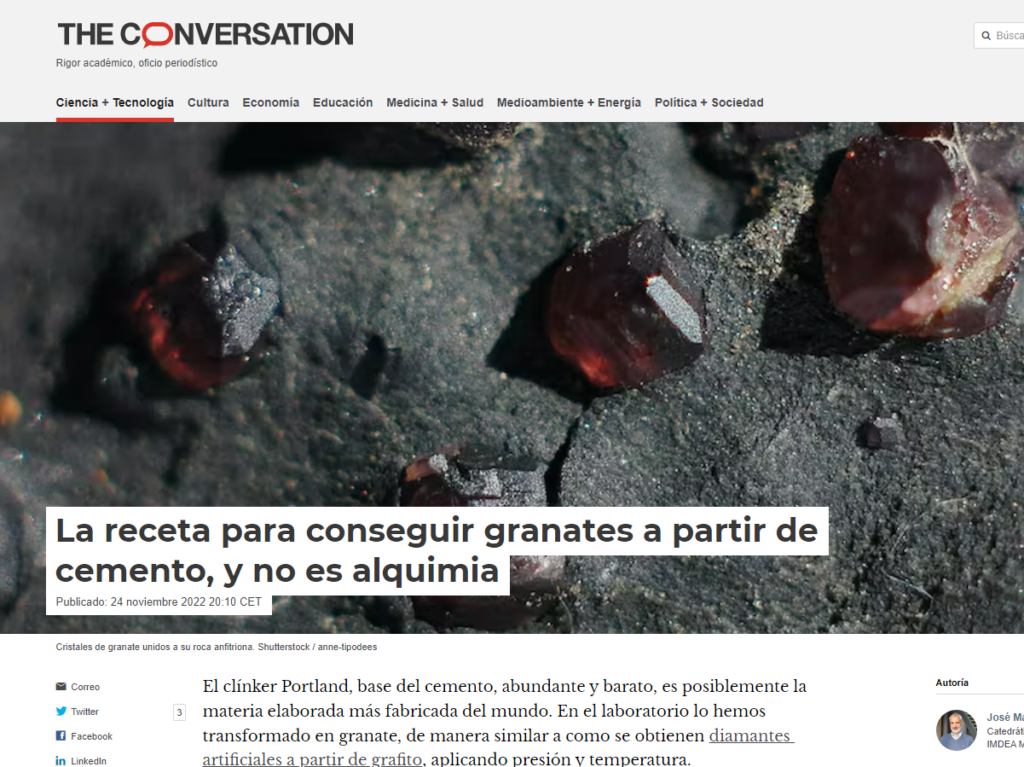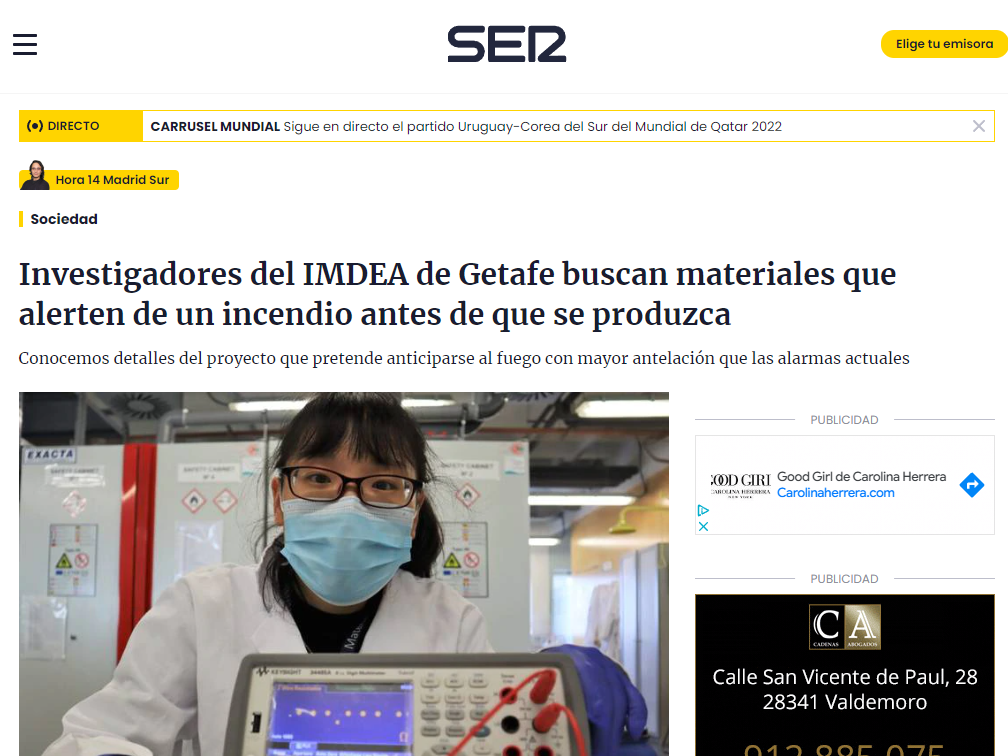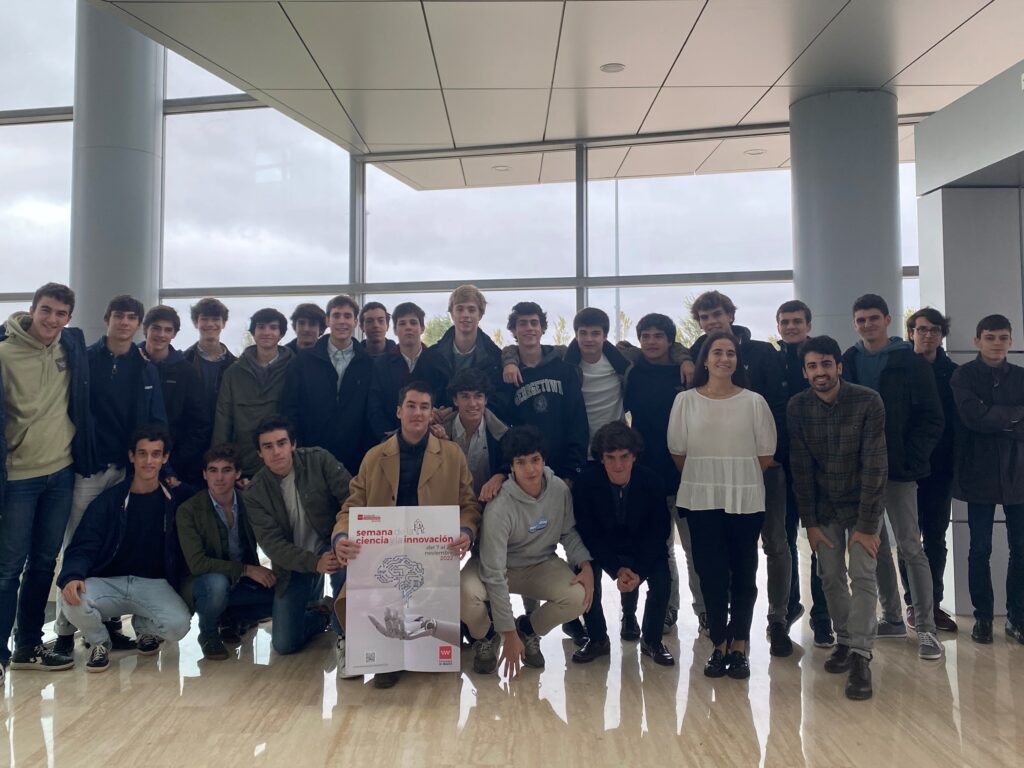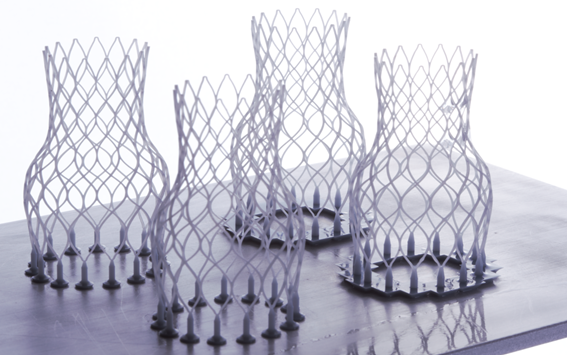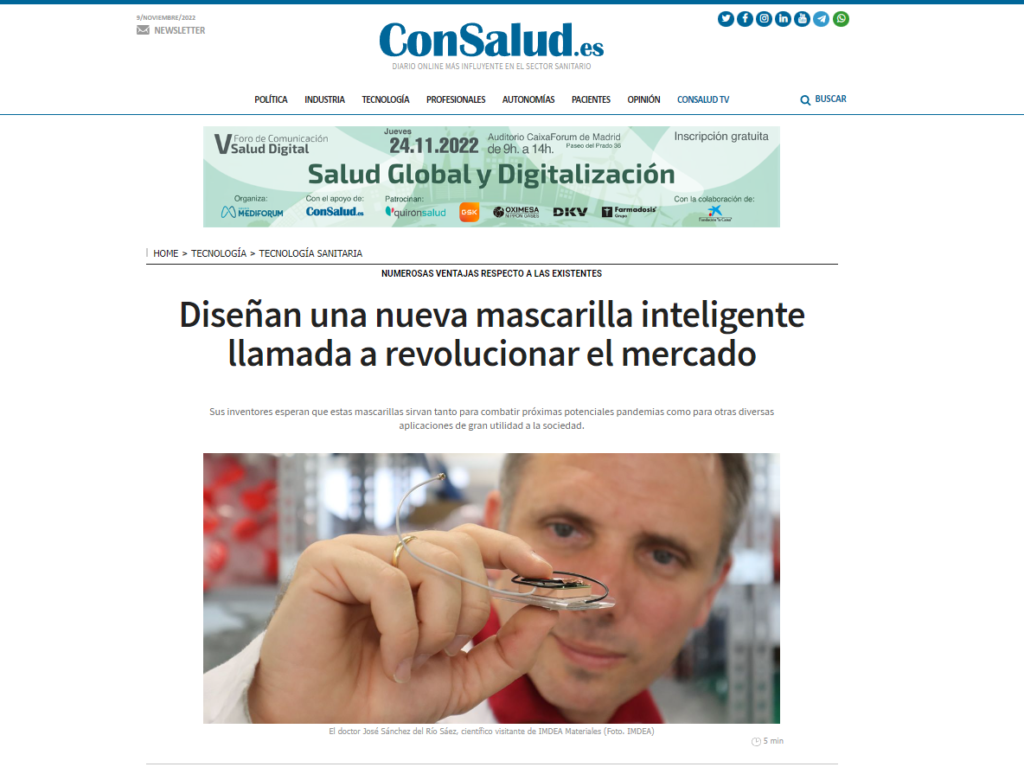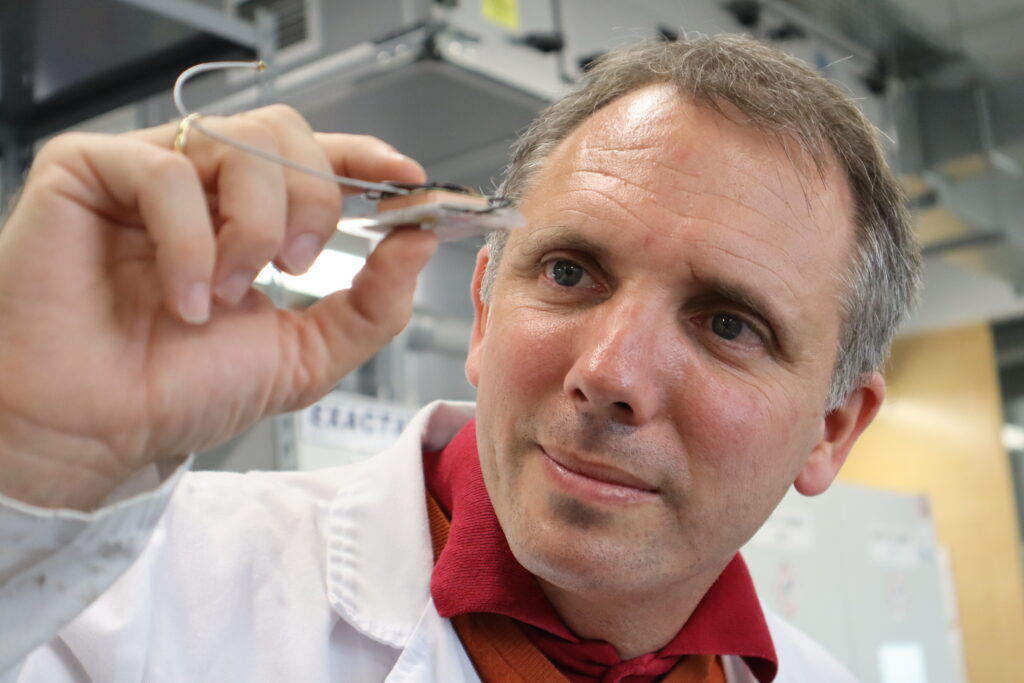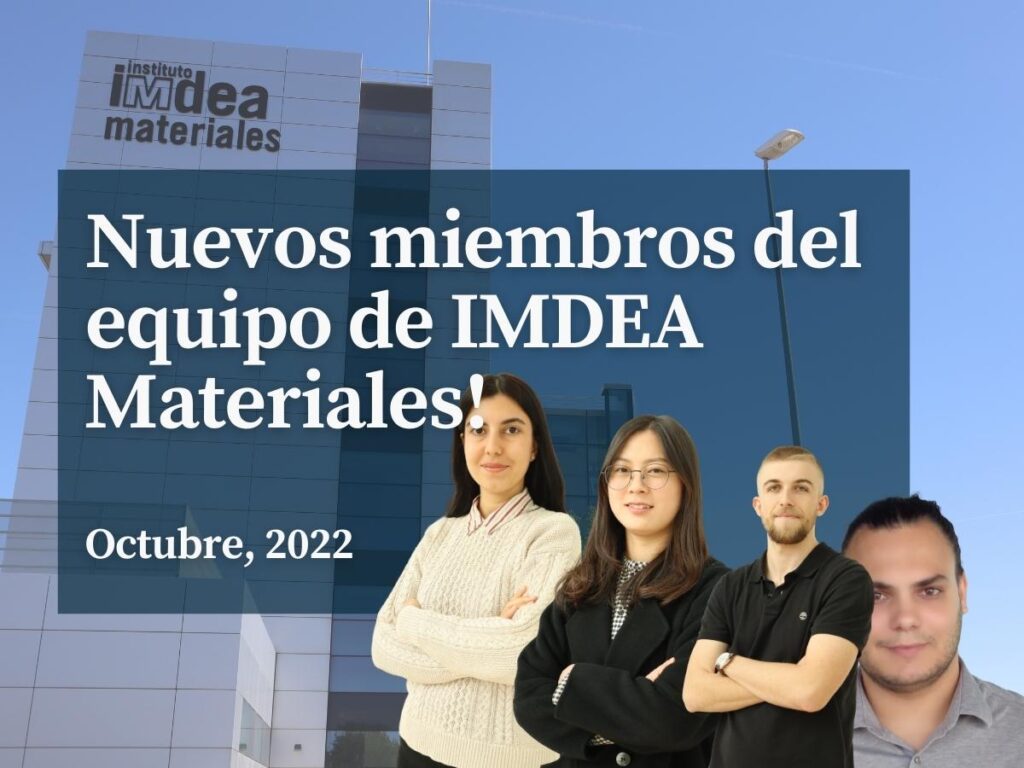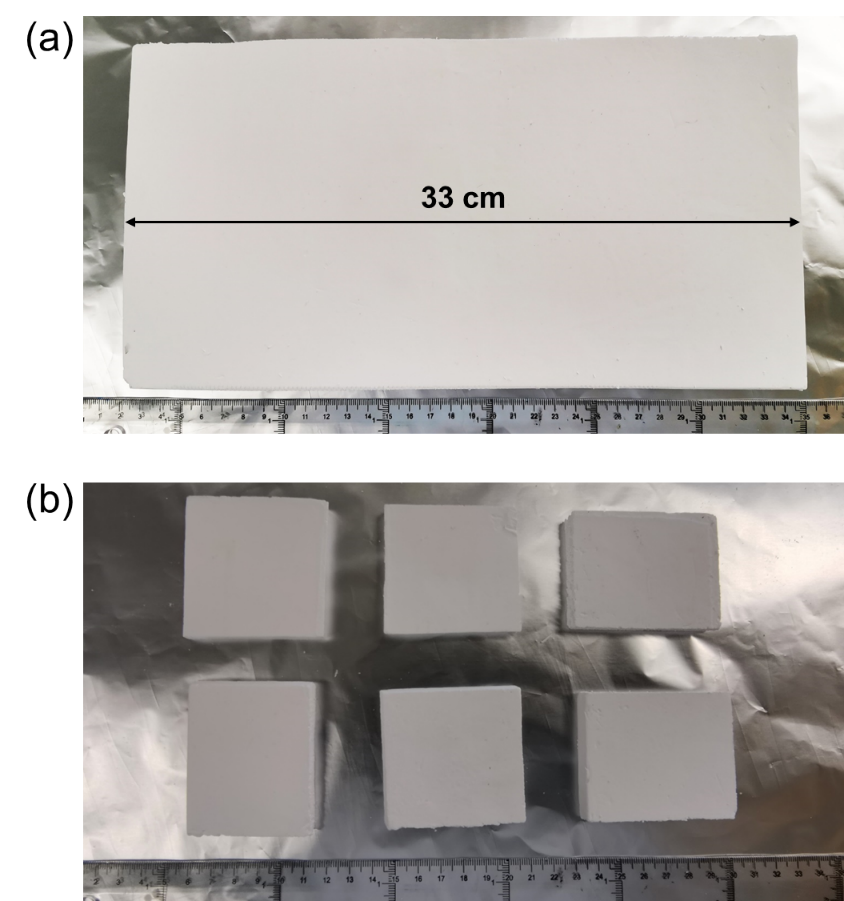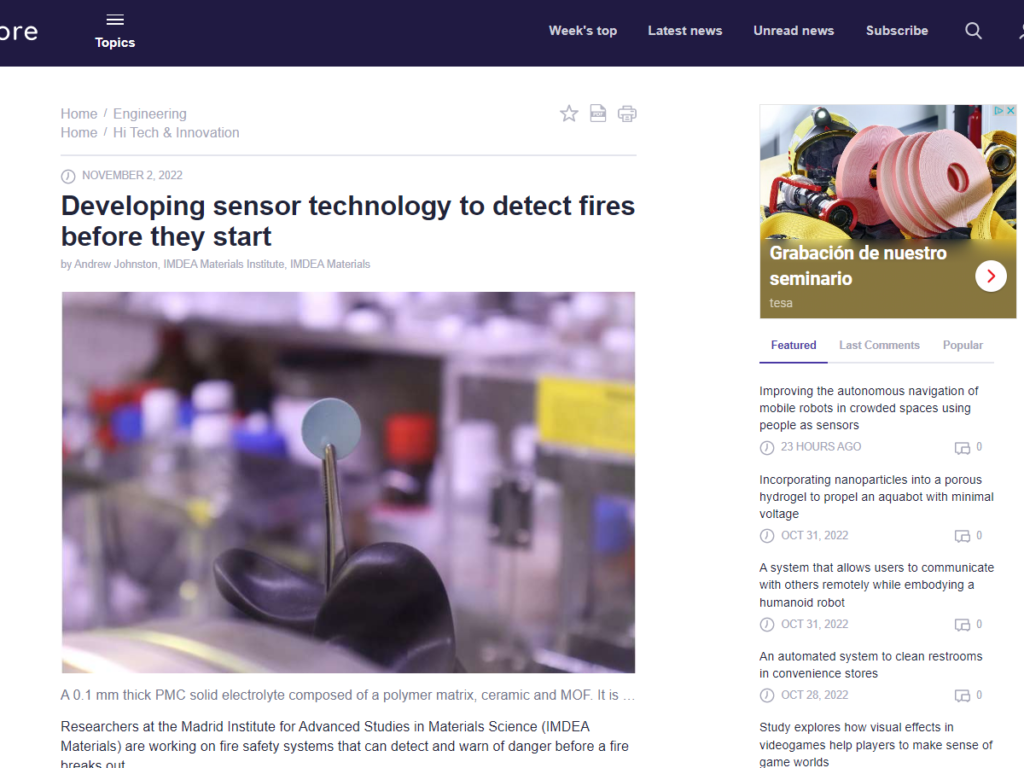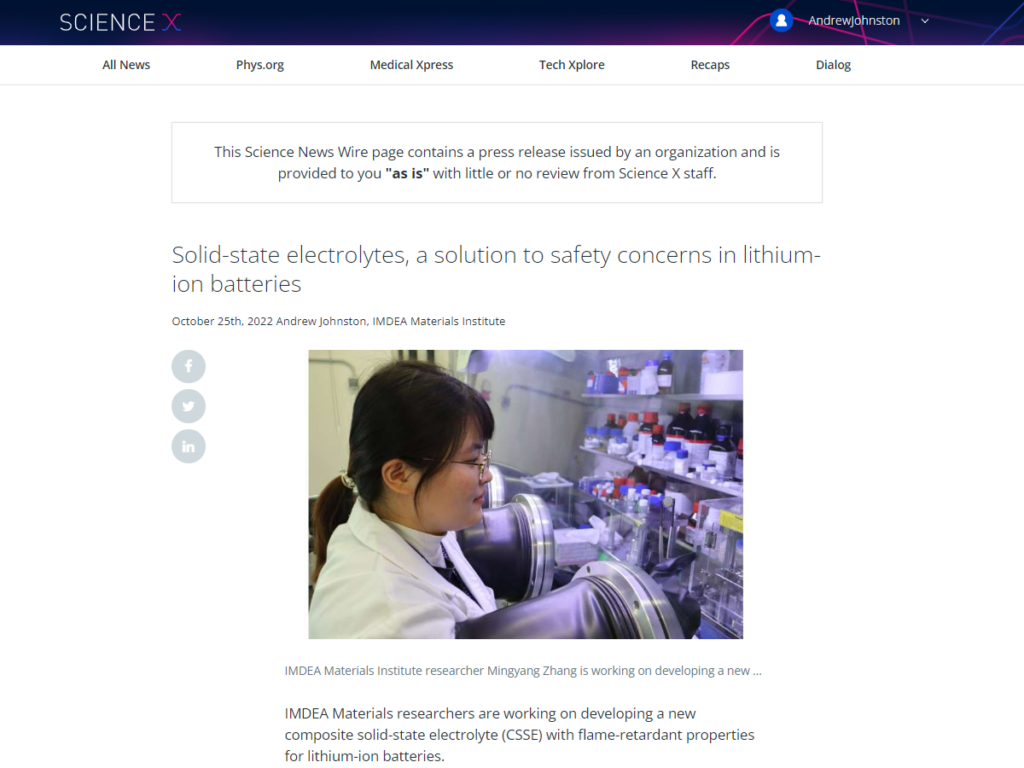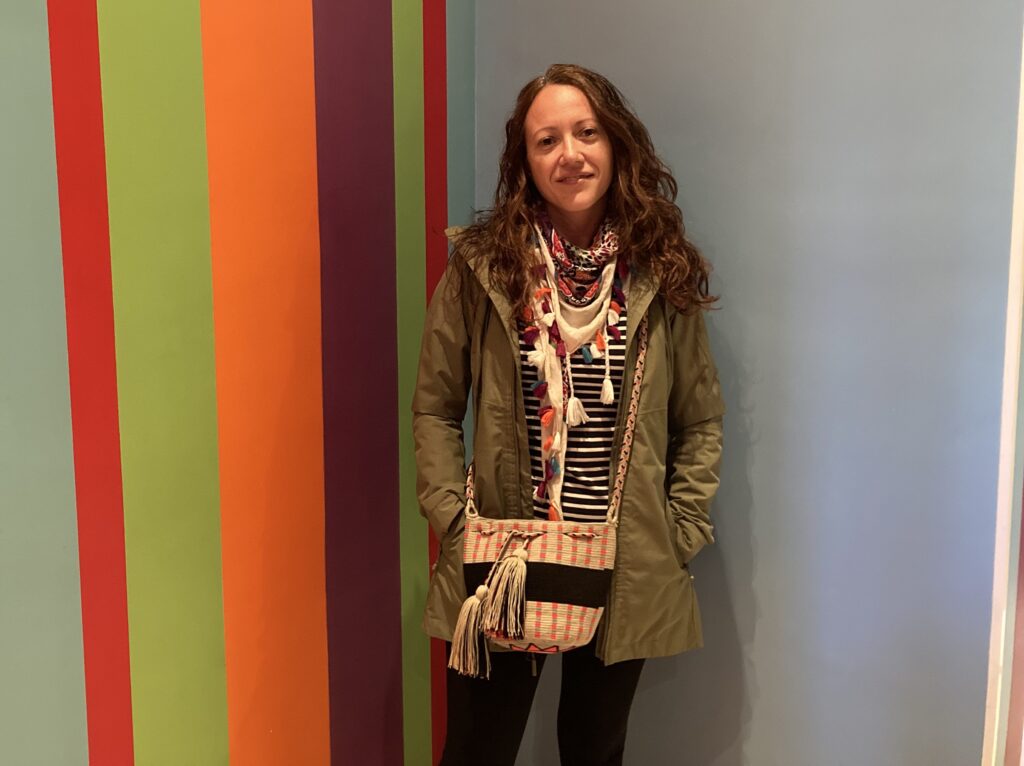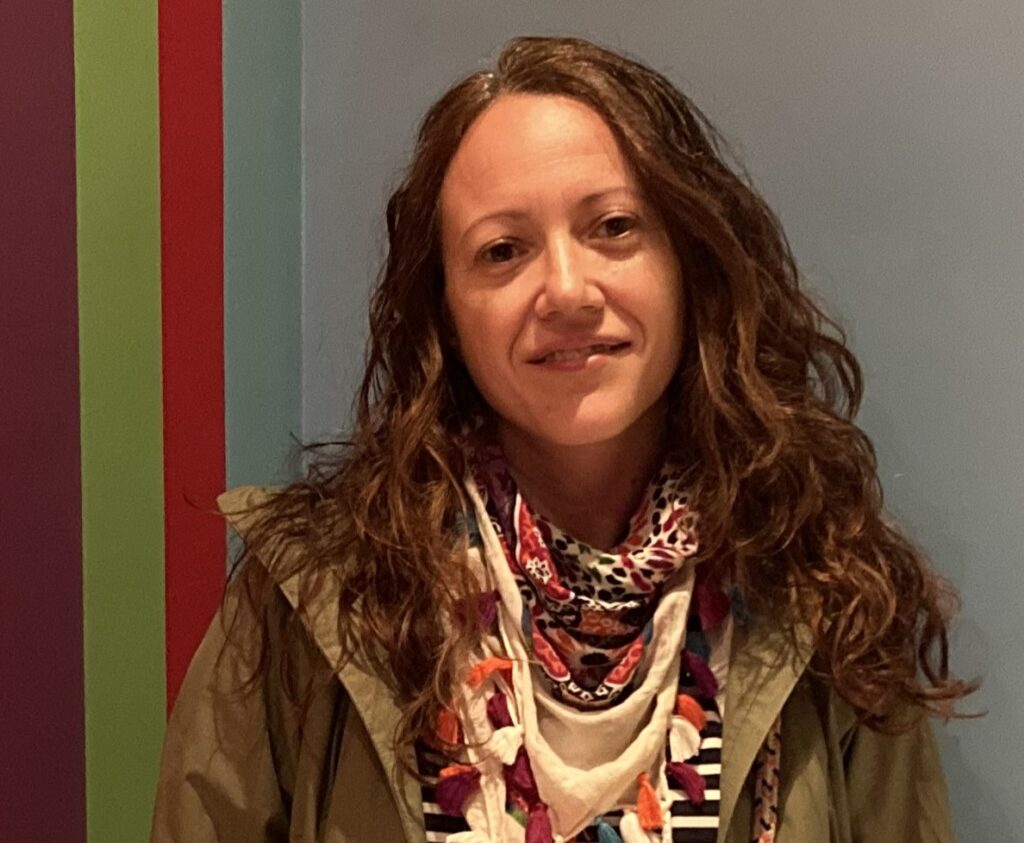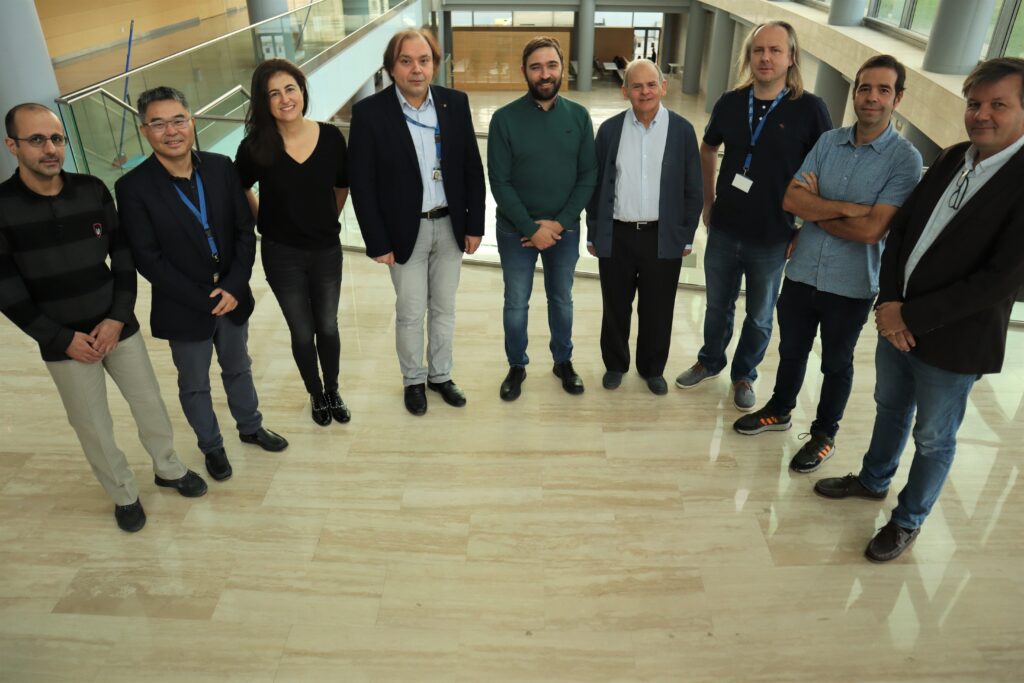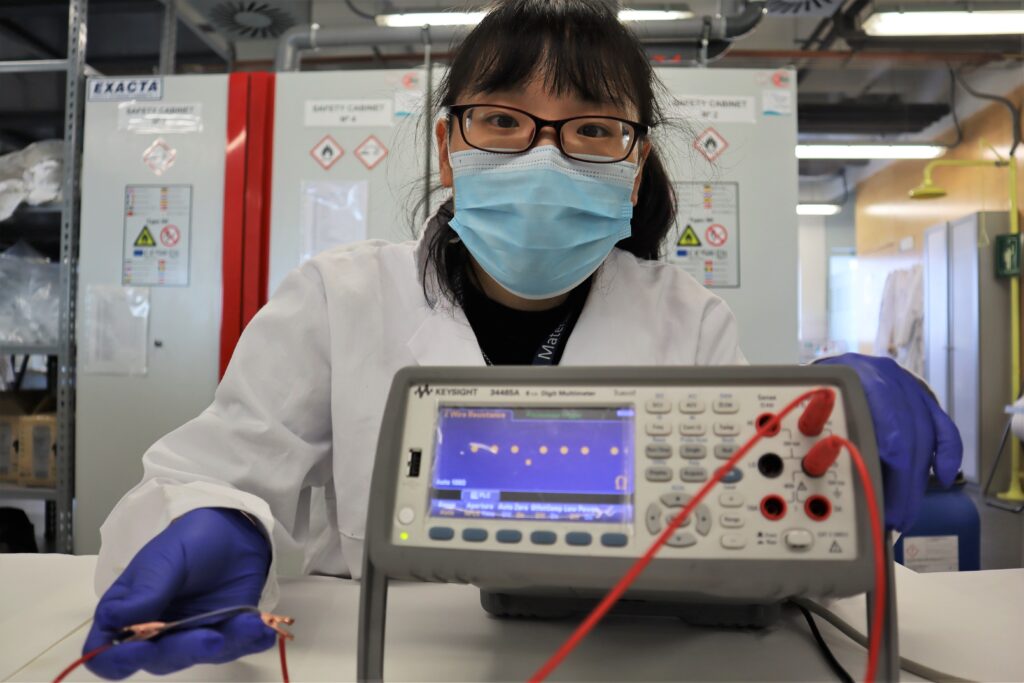Plasma-Derived Fibrin Hydrogels Containing Graphene Oxide for Infections Treatment
Ser becario postdoctoral Marie Skłodowska-Curie Actions (MSCA) en IMDEA Materiales – Webinario
¿Estás interesado en solicitar una Beca Postdoctoral de Acciones Marie Skłodowska-Curie (MSCA PF) en la convocatoria 2023? ¿Quieres saber cómo es ser becario MSCA PF en nuestro Instituto? Únete a nuestro seminario web el 1 de junio a las 12pm (GMT +2) y conoce más sobre nuestras ofertas de
Cupric ion decorated ammonium polyphosphate as an effective flame retardant for thermoplastic polyurethane
Defensa de doctorado de Shruti Banait, titulada «Effect of Microstructure on Architected Materials Fabricated by Additive Manufacturing» – 8 de junio de 2023
La Defensa de Doctorado tendrá lugar a las 11:00 horas, en la “Sala de Adoración de Miguel 1.2.C16” de la Universidad Carlos III de Madrid en Leganés. La disertación se titula " Effect of Microstructure on Architected Materials Fabricated by Additive Manufacturing ". Fue asesorada por la Dra.
DELIGHTED poster presentation on the 8th International Conference on Recrystallization and Grain Growth (REX&GG)
The DELIGHTED members continue to actively disseminate the outcomes of the project. Dr. Alexandros Banis from the University of Gent participated in the 8th International Conference on Recrystallization and Grain Growth (REX&GG) 2023 in Copenhagen, Denmark, from May 15 to 19, 2023. The
Effect of Carbon Content on Wear Behavior of Ni-Co-Cr-Mo-Cu Alloy
Homopolymeric Protein Phosphors: Overpassing the Stability Frontier of Deep-Red Bio-Hybrid Light-Emitting Diodes
El Instituto IMDEA Materiales se une a un proyecto europeo para hacer realidad el sueño de una aviación limpia
El Instituto IMDEA Materiales forma parte de un gran consorcio europeo que está trabajando en desarrollar el próximo avión regional eléctrico híbrido, que logrará una reducción de emisiones de hasta un 90%. El proyecto ‘Hybrid-Electric Regional Architecture’ (HERA), liderado por el gigante
An Experimental, Computational, and Statistical Strategy for the Bayesian Calibration of Complex Material Models
Scaling laws for two-dimensional dendritic crystal growth in a narrow channel
Centrifugal Force-Spinning to Obtain Multifunctional Fibers of PLA Reinforced with Functionalized Silver Nanoparticles
Multi-functional solvent-free SiO2 nanofluid simultaneously improve major properties and fluidity of epoxy resin: A new strategy beyond nanofillers
Seminario del Dr. Carlos Doñate, de la Universidad de Wuppertal, titulado: “Laser synthesized nanoparticles to enhance additive manufacturing materials: From ODS steels to plasmonic and magnetic polymers ”. El día 23 de junio, a las 12:00 hr, en la sala de Seminarios.
Abstract: Photonics, Nanotechnology and Advanced Materials are considered by the European Commission as key enabling technology due to the transcendental fields where these technologies have proved their capacity to provide solutions, as improved sensors, imaging and treatment in medicine, or
Twin suppression by atomic scale engineering of precipitate-matrix interfaces
Deformation and failure of the CrCoNi medium-entropy alloy subjected to extreme shock loading
Gas-to-nanotextile: high-performance materials from floating 1D nanoparticles
Jornada informativa para la convocatoria Marie Skłodowska-Curie Actions PFs 2023
Los investigadores del Instituto IMDEA Materiales, Prof. Javier Segurado y Dr. Carlos Ruestes, han participado en un webinario informativo sobre la convocatoria de becas postdoctorales Marie Skłodowska-Curie Actions (MSCA) 2023. El seminario está dirigido a los potenciales solicitantes de la
A quantitive microplasticity-based approach to rationalize the poor strengthening response of polycrystalline Mg alloys
High-velocity impact fragmentation of additively-manufactured metallic tubes
Friction Resistance of Uncured Carbon/Epoxy Prepregs under Thermoforming Process Conditions: Experiments and Modelling
Nuevos miembros del equipo – Marzo y Abril, 2023
Mi nombre es Joris Audoux. Soy de Limoges, Francia. Actualmente estoy en mi primer año de ingeniería en mecatrónica en ENSIL-ENSCI en Limoges. Mi estancia en IMDEA Materiales me permite desarrollar mis habilidades en los campos de informática y electrónica gracias al proyecto del Prof. Maciej
FYA de Biaobiao Yang, titulado: «Deformation mechanisms of dual-textured Mg-6.5Zn alloy with limited tension-compression yield asymmetry». El día 28 de mayo, a las 12:00 hr, en la sala de Seminarios.
Resumen: Despite that Mg has a lot of possible applications, the easiest deformation mechanism in Mg alloys, basal slip, can only provide two independent slip systems, leading to large plastic anisotropy and poor mechanical properties of Mg alloys at room temperature, restricting the applications
High-efficient fire-safe epoxy enabled by bio-based atomic-level catalytic engineering
El reto de resolver los mayores desafíos de la sociedad al enfocarse en la escala más pequeña
Una red de investigación interdisciplinaria que reúne más de 77 organizaciones de 24 países europeos busca hacer progresos significativos en las pruebas, simulación y caracterización de materiales a escala nano. Así se facilitará el desarrollo de nuevos materiales con mejores prestaciones y
Seminario de la Dra. Rebeca Hernández, del Instituto de Ciencia y Tecnología de Polímeros (CSIC), titulado: “Design of Polymer Hydrogels as Biomaterial Inks for 3d Extrusion Printing”. El día 28 de abril, a las 10:30 hr, en la sala de Seminarios.
Abstract: 3D extrusion printing has evolved as one of the most employed manufacturing techniques for the fabrication of polymer scaffolds for applications in tissue engineering. Within the context, the selection of the polymer hydrogel to be employed as biomaterial ink is crucial and several
IMDEA Materiales abre sus ofertas para la convocatoria 2023 de las becas postdoctorales MSCA
El Instituto IMDEA Materiales busca candidatos para la convocatoria 2023 de las becas postdoctorales de las Acciones Marie Skłodowska-Curie (MSCA-PF), con fecha límite de presentación de propuestas el 13/09/2023. En IMDEA Materiales tenemos una larga experiencia en el programa MSCA y hemos
Shaped Photothermal Conversion Phase-Change Materials with Excellent Electromagnetic Shielding Performance and Flame Retardancy
PORMETALOMICS avanza en su misión de ampliar el conocimiento de los metales porosos ligeros y sus aplicaciones
El Instituto IMDEA Materiales ha acogido la primera reunión presencial del proyecto europeo PORMETALOMICS. A la reunión asistieron representantes de los tres socios del proyecto: el Instituto IMDEA Materiales (coordinadores del proyecto), Technion - Instituto de Tecnología de Israel y el
El primer proceso de modificación superficial escalable y continuo para alambres de magnesio – SURFAS
La publicación SURFAS ha destacado el trabajo de los investigadores del Instituto IMDEA Materiales y Meotec en el desarrollo del primer proceso de modificación superficial escalable y continuo del mundo para alambres de aleaciones de magnesio. Puede consultar el artículo en el siguiente enlace:
Binder jet green parts microstructure: advanced quantitative analysis
Seminario del Prof. Micah Green, de la Universidad Texas A & M, titulado: «Using Radio Frequency Fields for Heating, Curing, Welding, and 3D printing ». El día 12 de mayo, a las 12:00 hr, en la sala de Seminarios.
Resumen: Carbon nanomaterials show remarkable heating rates in response to applied radio frequency (RF) fields. We can now show that these responses may be generalized across a wide range of nanomaterial-loaded structures, including carbon nanotubes, carbon nanofibers, and laser-induced graphene.
IMDEA Materiales participa en el proyecto SM@RTM para mejorar la competitividad de los procesos RTM
El proceso de fabricación de materiales compuestos por transferencia de resina (Resin Transfer Molding, RTM) ofrece grandes ventajas para la fabricación de materiales compuestos de alto rendimiento como la capacidad de obtener geometrías de gran acabado superficial y dimensiones cercanas a la
Unidirectional spin-wave edge modes in magnonic crystal
El Instituto IMDEA Materiales acoge la reunión final del Proyecto MAT4.0-CM de la Comunidad de Madrid
El Instituto IMDEA Materiales ha acogido hoy la reunión final de MAT4.0-CM, un proyecto diseñado para avanzar en la fabricación inteligente de materiales avanzados para la energía, el transporte y la salud. MAT4.0-CM está coordinado por IMDEA Materiales y tiene como objetivo promover la
Seminario del Dr. Pawel Dlutko, titulado “Firmas topológicas de porosidad”, y del Dr. Bartosz Naskrecki, titulado “Funciones de crecimiento de teselaciones espaciales periódicas” – 25 de abril de 2023
Spark discharge generator as a stable and reliable nanoparticle synthesis device: Analysis of the impact of process and circuit variables on the characteristics of synthesized nanoparticles
El Instituto IMDEA Materiales acoge la visita del IES Juan Antonio Fraguas Forges
El Instituto IMDEA Materiales ha recibido hoy la visita de unos 40 estudiantes del IES Juan Antonio Fraguas Forges, como parte de nuestra misión continua de difundir el interés y la concienciación por la ciencia y la investigación entre las generaciones más jóvenes. Como parte de la visita, el
(ELECTROFLOAT) ELECTRODE ASSEMBLY FROM FLOATING NANOWIRES FOR SUSTAINABLE NEXT GENERATION BATTERIES
Project details Funding: ERC-2022-POC1. HORIZON ERC Proof of Concept Grants. European Research Council Executive Agency (ERCEA)Project coordinator: IMDEA Materials.Project period: 01/09/2022 – 31/08/2027 IMDEA Materials' researchers Dr. Juan José Vilatela Abstract It is
(RECOIL3D) DYNAMIC COIL-SHAPED POLYLACTIC ACID-REINFORCED EXTRACELLULAR MATRIX-DERIVED SCAFFOLD WITH ORIENTED PORES FOR ARTICULAR CARTILAGE TISSUE ENGINEERING
Project details Funding: MSCA Postdoctoral Fellowships 2021. HORIZON-MSCA-2021-PF-01Project coordinator: IMDEA Materials Project period: 01/04/2023 – 31/03/2025 IMDEA Materials' researchers Supervisor: Dra. Jennifer PattersonFellow: Pedro José Díaz Payno Abstract Articular
Emerging topics in nanophononics and elastic, acoustic, and mechanical metamaterials: an overview
Webinar: Sesión informativa para la convocatoria de proyectos postdoctorales MSCA 2023
IMDEA Materiales puede anunciar que, tras nuestro tremendo éxito en los Proyectos Postdoctorales Marie Skłodowska-Curie Actions 2022, ¡hemos sido invitados a compartir nuestra experiencia en la próxima jornada informativa para candidatos de la convocatoria 2023! La sesión será el martes 25 de
El Dr. Damien Tourret, del Instituto IMDEA Materiales, nombrado «Young Leaders International Scholar» 2023
El Dr. Damien Tourret, líder del grupo de investigación Modelado y Simulación de Procesado de Materiales de IMDEA Materiales, ha sido nombrado el 2023 "Young Leaders International Scholar" por TMS de los Estados Unidos y el Instituto Japonesa de Metales y Materiales (JIM). Este galardón, que
El IMDEA Materiales desarrolla técnica para fabricar alambres bioabsorbibles – La Vanguardia
La Vanguardia ha destacado cómo IMDEA Materiales y Meotec han creado el primer proceso continuo e industrialmente escalable del mundo para la modificación superficial de alambres de aleación de magnesio bioabsorbibles. Puedes leer el artículo completo, aquí:
«First Year Assessment» de Wei Shao, titulado «First principles prediction of Al-based binary phase diagram»- 21 de abril, 2023 – 12:30 pm.
Resumen: Aluminum alloys have been the primary material of choice for structural components of aircraft,among which Al-Li, Al-Ni, Al-Co and Al-Cu alloy have attracted much attention due to theirexceptional fracture toughness, corrosion resistance and so on. Understanding the relationshipsamong
La startup que ya define la nueva generación de baterías, ABC.es
El periódico español ABC.es ha publicado un artículo sobre Floatech, una startup y spin off del Instituto IMDEA Materiales, que está a punto de abrir su primera planta piloto para la producción a escala industrial de sus ánodos 100% de silicio para baterías de iones de litio. Puedes leer el
Processing of Composite Electrodes of Carbon Nanotube Fabrics and Inorganic Matrices via Rapid Joule Heating
Estudiantes exploran oportunidades de doctorado en el Instituto IMDEA Materiales en el «Open PhD Day»
El Instituto IMDEA Materiales organizó hoy su "Open PhD Day" para estudiantes interesados en realizar su doctorado en diversos campos relacionados con la ciencia de materiales. IMDEA Materiales es uno de los principales institutos de España para llevar a cabo un doctorado, debido a su nivel de
Critical resolved shear stresses for slip and twinning in Mg-Y-Ca alloys and their effect on the ductility
UV and aging effect on the degradation of PEDOT:PSS/nSi films for Hybrid Silicon solar cells
El Secreto de las Espadas de Damasco – The Conversation
Este artículo de The Conversation Spain, escrito por los investigadores del IMDEA Materiales, el Prof. José Manuel Torralba y el Dr. Ilchat Sabirov, explora el enigma de las espadas de Damasco, famosas por su filo y belleza. El artículo explora la técnica de forjado y templado utilizada por los
A deep encoder-decoder for surrogate modelling of liquid moulding of composites
El secreto de las espadas de Damasco, legendarias por su gran dureza y filo “casi eterno”
José Manuel Torralba, IMDEA MATERIALES y Ilchat Sabirov, IMDEA MATERIALES Las espadas de acero de Damasco eran legendarias por su gran dureza y tenacidad y su filo “casi eterno”. Podían cortar seda y también despedazar una roca. El sultán Saladino impresionó a Ricardo Corazón de León en una
IMDEA Materiales investiga un dispositivo portátil que mejora la circulación – La Vanguardia
El diario La Vanguardia ha publicado un artículo sobre el Proyecto RETOVEN, una colaboración entre la empresa española de tecnología médica ZoeTech y el Instituto IMDEA Materiales para crear un dispositivo que mejore la circulación sanguínea. Puede leer el artículo completo aquí:
Methodology to design and optimise dispersed continuous carbon fibre composites parts by fused filament fabrication
Investigadores desarrollan un proceso escalable y continuo de modificación superficial de alambres de aleación de magnesio – Phys.org
Phys.org ha destacado la investigación reciente del Instituto IMDEA Materiales y el fabricante alemán de equipos médicos Meotec GmbH, sobre el desarrollo del primer proceso de modificación de superficies escalable industrialmente del mundo para alambres de aleación de magnesio bioabsorbibles. Los
Small core of piperazine/silane aggregation initiate efficient charring flame retardant effect in polypropylene composites
IMDEA Materiales y Meotec desarrollan el primer proceso de modificación superficial escalable y continuo del mundo para alambres de aleación de magnesio
Investigadores de IMDEA Materiales y el fabricante alemán de equipos médicos Meotec GmbH han creado el primer proceso continuo y escalable de forma industrial para la modificación superficial de alambres de aleación de magnesio bioabsorbibles del mundo. Los resultados, recogidos en dos artículos
Enhanced wear resistance while maintaining transparency of epoxy resin coatings filled with novel one-dimensional magnesium borate hydroxide nanorods
IMDEA Materiales y ZoeTech colaboran para el desarrollo de un nuevo dispositivo portátil que mejore la circulación sanguínea
El Instituto IMDEA Materiales está colaborando con la compañía de tecnologías de salud con sede en Madrid, ZoeTech, para crear un nuevo dispositivo portátil que mejore la circulación sanguínea. El proyecto RETOVEN tiene como objetivo desarrollar la tecnología que ayudará a personas que padecen
(HIGHHYDROGENML) HIGH-THROUGHPUT DISCOVERY OF CATALYSTS FOR THE HYDROGEN ECONOMY THROUGH MACHINE LEARNING
Project details Funding: MSCA Postdoctoral Fellowships 2022. HORIZON-MSCA-2022-PF-01 Project coordinator: IMDEA Materials Project period: 01/04/2023 – 31/03/2025 IMDEA Materials' researchers Supervisor: Dr. Javier LLorca Martínez Fellow: Valentín Vassilev Galindo Abstract Hydrogen
Potential energy-assisted coupling of phase change materials with triboelectric nanogenerator enabling a thermally triggered, smart, and self-powered IoT thermal and fire hazard sensor: Design, fabrication, and applications
Alumni en el punto de mira – Nathamar Dudamell
Cuando la Dra. Nathamar Dudamell, antigua investigadora del Instituto IMDEA Materiales, recibió una llamada del Ayuntamiento de Humanes de Madrid, su hogar durante los últimos 15 años, al principio se esperaba lo peor. Así que, fue una sorpresa especialmente agradable cuando resultó que la
(MAD2D) Two-dimensional (2D) disruptive materials for the new technological transformation
Project details Funding: Plan complementario en el área de materiales avanzados en el marco del componente 17, inversión del Plan de Recuperación, Transformación y Resiliencia financiado por la UEProject coordinator: Universidad Complutense de MadridProject period: 01/01/2021 –
Floatech, la startup madrileña que planea fabricar ánodos de silicio a escala industrial con su primera planta piloto – Batteries News
Batteries News ha cubierto la noticia de los planes de Floatech de abrir su primera planta piloto para la fabricación a escala industrial de sus ánodos patentados 100% de silicio para la próxima generación de baterías de iones de litio. Puede leer el artículo completo, aquí:
Role of surface carbon nanolayer on the activation of flash sintering in tungsten carbide
Floatech, la startup madrileña que apuesta por la fabricación a escala industrial de ánodos de silicio con su primera planta piloto
Floatech, spin-off madrileña del Instituto IMDEA Materiales, tiene previsto abrir su primera planta piloto para la fabricación de ánodos de silicio este año. Los ánodos de silicio serán vitales para la próxima generación de baterías de litio (LIBs) que impulsarán los vehículos eléctricos del
Strategic design unsaturated polyester resins composites with excellent flame retardancy and high tensile strength
Los científicos del futuro se citan en IFEMA – TeleMadrid
TeleMadrid ha presentado a la investigadora de IMDEA Materiales, Dra. Mónica Echeverry en su cobertura de la Feria Madrid es Ciencia, 2023. Puede consultar el reportaje completo, aquí:
Layer-by-layer assembly of calixarene modified GO and LDH nanostructures on flame retardancy, smoke suppression, and dye adsorption behavior of flexible polyurethane foams
IMDEA Materiales busca ampliar sus lazos con China
La colaboración entre el Instituto IMDEA Materiales y la Asociación China para la Ciencia y la Tecnología (CAST) podría dar lugar a mayores oportunidades de intercambio de estudiantes y talentos entre ambos países. Y unos lazos más estrechos también podrían brindar oportunidades para nuevas
Analysis of Stress Intensity Factor of a Fibre Embedded in a Matrix
El Director Científico de IMDEA Materiales, Prof. Javier LLorca, el primer español en recibir el Premio Científico/Ingeniero Distinguido de la División de Materiales Estructurales de TMS
- El Prof. Javier LLorca recibió el premio en la Reunión Anual de la Sociedad de Minerales, Metales y Materiales (TMS). - El Prof. LLorca, también catedrático de Ciencia de Materiales en la Universidad Politécnica de Madrid (UPM), es el fundador del Instituto IMDEA Materiales y su actual Director
Room temperature stability, structure and mechanical properties of cubic tungsten carbide in flash sintered products
Continuous intercalation compound fibers of bromine wires and aligned CNTs for high-performance conductors
IMDEA Materiales celebra su 12º Concurso Anual de Imagen
El Instituto IMDEA Materiales ha celebrado hoy la entrega de premios con la que finaliza el 12º Concurso Anual de Imagen. El concurso de este año ha estado dominado por la categoría de Caracterización de Materiales, que ha aportado la mayoría de las imágenes presentadas, por delante de las de
El futuro de la medicina regenerativa se acerca al presente en el Instituto IMDEA Materiales
Blanca Martínez / Andrés Gerlotti En la actualidad, quienes padecen lesiones en los huesos o cartílagos pueden optar por implantes o prótesis metálicas en su tratamiento médico, con una duración de aproximadamente quince años. Pero ahora que los pacientes cada vez viven más tiempo, resultan
Osteoarticular-inspiring manipulation of bio-based exfoliated boron nitride for fire-safe, strong yet tough epoxy
El IMDEA Materiales incorpora herramienta clave frente a futuras pandemias – La Vanguardia
La Vanguardia ha destacado la adquisición por parte de IMDEA Materiales de una nueva herramienta para caracterizar, diseñar y crear materiales nuevos con una gama amplia de aplicaciones, incluidos los dispositivos biomédicos de nueva generación, que permitirá revelar secretos ocultos en materiales y
Linking discrete and continuum diffusion models: Well-posedness and stable finite element discretizations
Corrosion Resistance and Biological Properties of Pure Magnesium Modified by PEO in Alkaline Phosphate Solutions
Reducing model complexity by means of the optimal scaling: Population balance model for latex particles morphology formation
First principles prediction of the Al-Li phase diagram including configurational and vibrational entropic contributions
Seminario del Dr. Miroslav Zezevic, de los Los Alamos National Laboratory (USA), titulado «Large Strain Crystal Plasticity Gradient Model Based on FFTs: Formulation, Implementation and Application.». El día 8 de marzo, a las 12:30 hr, en la Sala de Seminarios.
Resumen, Robust and efficient full-field crystal plasticity models (based on finite element or FFT methods) have been developed over the past decades, and were extensively used for simulating and understanding different material phenomena at the macro- and mesoscales. On the other hand, nanoscale
Cómo revelar los secretos ocultos en el interior de los materiales puede ayudar a combatir futuras pandemias
Los investigadores del Instituto IMDEA Materiales disponen ahora de una nueva y potente herramienta para caracterizar, diseñar y crear nuevos materiales con una amplia gama de aplicaciones, incluidos los dispositivos biomédicos de nueva generación. IMDEA Materiales se ha convertido recientemente
Nuevos miembros del equipo – Febrero, 2023
Cada mes, damos la bienvenida a nuevos miembros del equipo de IMDEA Materiales. Aquí, puedes encontrar un breve perfil de nuestras incorporaciones más recientes. Hola, soy José Ignacio Delgado y soy de Torrejón, cerca de Madrid. Tengo un máster en Ingeniería de Materiales por la Universidad de
Ceria-based coatings on magnesium alloys for biomedical applications: a literature review
Unveiling the structure, chemistry, and formation mechanism of an in-situ phosphazene flame retardant-derived interphase layer in LiFePO4 cathode
El Monte Everest, pasarela de moda técnica: de la lana y el cuero al Gore-Tex – The Conversation
Con la llegada de la nieve, los amantes del esquí y los deportes de montaña pueden sonreír tranquilos. Les llega la hora de abrir los armarios y sacar esa vestimenta diseñada para soportar condiciones adversas y extremas de frío, nieve y viento. ¿Quieres saber más? Para seguir leyendo este
Broadband Acoustic Metaveils for Configurable Camouflage
Sergio Sadaba
El Dr. Sergio Sadaba, antiguo alumno del Instituto IMDEA Materiales e Ingeniero Senior de Proyectos de Ingeniería Asistida por Ordenador (CAE), cree que los investigadores podrían estar alcanzando por fin un punto de inflexión en el desarrollo de la tecnología de reactores de fusión
Accurate determination of active slip systems for improved geometrical criteria of basal-to-basal slip transfer at grain boundaries in pure Mg
IMDEA Materiales expone el presente y el futuro de la ciencia de materiales en Madrid
¿Tienes curiosidad por los materiales que nos rodean? ¿Te interesa conocer más de los materiales necesarios para crear baterías, implantes médicos o componentes aeronáuticos de última generación? Si es así, acércate mañana al Círculo de Bellas Artes entre las 11:00 y las 19:00 horas, donde
Temperature-dependent photoluminescence of anatase Li-doped TiO2 nanoparticles
Defensa de doctorado de Chandrashekhar Pilgar, titulada «Microstucture sensitive simulation framework for additive manufactured Hastelloy-X» – 24 de Febrero de 2023.
La Defensa de Doctorado tendrá lugar a las 11:00 horas, en la “sala verde” de la Escuela Técnica Superior de Ingenieros de Caminos, Canales y Puertos. La disertación se titula «Microstucture sensitive simulation framework for additive manufactured Hastelloy-X». Fue asesorado por el Prof. Javier
Holy Water: Photo-Brightening in Quasi-2D Perovskite Films under Ambient Enables Highly Performing Light-Emitting Diodes
ConstructAdd da un paso más en su misión de generalizar la fabricación aditiva de acero
- Los 11 miembros en ConstructAdd, incluidos socios académicos y fabricantes de maquinaria y acero, se reunieron en el Instituto IMDEA Materiales para celebrar la segunda reunión de progreso del proyecto. - ConstructAdd pretende facilitar la adopción generalizada de la fabricación aditiva
An implicit FFT-based method for wave propagation in elastic heterogeneous media
Ultrafast synthesis of SiC nanowire webs by floating catalysts rationalised through in situ measurements and thermodynamic calculations
IMDEA Materiales consigue una tasa de éxito sin precedentes en la última convocatoria de becas MSCA
- IMDEA Materiales ha obtenido seis becas postdoctorales Marie Skłodowska-Curie en la convocatoria de 2022. El 40% de las propuestas del Instituto han sido seleccionadas. - Los proyectos que se desarrollarán a través de las nuevas becas abarcan diversos campos, como la medicina regenerativa, el
El rostro cambiante de la ciencia
Blanca Limones representa el cambio generacional que se está produciendo en el mundo de la ciencia y la investigación. Limones, de 27 años, trabaja actualmente como Ayudante de Investigación en el Instituto IMDEA Materiales, donde forma parte del grupo de investigación de Biomateriales y Medicina
Polyacrylonitrile-b-Polystyrene Block Copolymer-Derived Hierarchical Porous Carbon Materials for Supercapacitor
«El panorama va cambiando» – Un homenaje a los rostros femeninos de IMDEA Materiales
Mónica Echeverry Rendon es bioingeniera e investigadora postdoctoral en el Instituto IMDEA Materiales. En este artículo, da continuidad a su post de hace un año en el que celebraba el Día Internacional de la Mujer y la Niña en la Ciencia. El año pasado, para conmemorar el Día Internacional de la
Cascos más seguros y zapatillas más cómodas: IMDEA Materiales busca optimizar los metamateriales impresos en 3D
Este sábado, el 11 de febrero, se celebra el Día de la Mujer en la Ciencia. Con este motivo, IMDEA Materiales quiere dar a conocer durante estos días el trabajo de tres de nuestras investigadoras. En este segundo artículo de tres, hablamos con la investigadora predoctoral Lucia Cobian sobre el
Bienal Ciudad y Ciencia – 21 – 26 de febrero
La tercera edición de la Bienal Ciudad y Ciencia se celebrará en Barcelona y Madrid entre los días 21 y 26 de febrero de 2023. La organización de la Bienal se hará con la colaboración del Círculo de Bellas Artes, impulsada por la Fundación Española para la Ciencia y la Tecnología (FECYT). Alíate
Effect of twin boundaries on the strength of body-centered cubic tungsten nanowires
«La ciencia no está considerada en la sociedad como cultura general» – La científica de IMDEA Materiales intenta cambiar la percepción de la investigación
Este sábado 11 de febrero se celebra el Día de la Mujer en la Ciencia. Con este motivo, IMDEA Materiales quiere dar a conocer durante estos días el trabajo de tres de nuestras investigadoras. En este primer artículo de tres, hablamos con la investigadora predoctoral Elena Sánchez. En su labor
Seminario del Dr. Jacobo Ayensa, del Laboratorio de Microambiente de Tejidos (TMELab), titulado «Physically-Guided Neural Networks with Internal Variables: from material unravelling to applications in biomedical engineering». El día 20 de febrero, a las 12:00 hr, en la Sala de Seminarios.
Resumen: Material modelling has been for decades the centre of scientific efforts in the field of computational mechanics. A high number of parametric nonlinear families have been proposed for modelling elastic and inelastic solids. However, model selection and parameter identification and
IMDEA Materiales formará parte de los nuevos clústeres de investigación de la Comunidad de Madrid
IMDEA Materiales será miembro fundador de tres de los recientemente lanzados Clústeres de Innovación, Tecnología y Talento de la Comunidad de Madrid. Los clústeres, cada uno dedicado a un área científica diferente, han sido diseñados para facilitar la colaboración público-privada, aumentar la
Highly efficient intumescent flame retardant of dopamine-modified ammonium polyphosphate for the thermoplastic polyurethane elastomer
Effect of microstructure on tensile properties of quenched and partitioned martensitic stainless steels
Seminario del Dr. Pedro Díaz Payno, postdoctorado en el grupo de Biomateriales y Medicina Regenerativa (proyecto BIOMET4D EIC Pathfinder -IMDEA Materiales), titulado: «Swelling-Dependent Shape-Based Transformation of a Human Mesenchymal Stromal Cells-Laden 4D Bioprinted Construct for Cartilage Tissue Engineering». El día 10 de febrero, a las 13:00 hr, en el Auditorio.
Resumen: 3D bioprinting is usually implemented on flat surfaces, posing serious limitations in the fabrication of multilayered curved constructs. 4D bioprinting, combining 3D bioprinting with time-dependent stimuli-induced transformation, enables the fabrication of shape-changing constructs.
Chemical structure construction of DOPO-containing compounds for flame retardancy of epoxy resin: A review
Microstructure sensitive fatigue life prediction model for SLM fabricated Hastelloy-X
El reto de detener el crecimiento de tumores cerebrales mediante campos eléctricos usando un dispositivo implantado alimentado remotamente
Un nuevo proyecto de investigación busca diseñar y fabricar un novedoso dispositivo para el tratamiento de tumores cerebrales que permita detener el crecimiento tumoral mediante la generación de campos eléctricos. Este dispositivo implantable podría extenderse en un futuro para tratar otro tipo
Construction of Nanomaterials Based on Molybdenum Disulfide Decorated onto a Metal-Organic Framework (UiO-66) to Improve the Fire Retardancy of Epoxy
Alberto Vicente
Jingyi Zhang
Arley Garcia
El Prof. Javier Segurado recibe el premio «Consolidación de la Actividad Investigadora» de la UPM
El Prof. Javier Segurado, líder del grupo de investigación Simulación Multiescala de Materiales de IMDEA Materiales, ha recibido recientemente el premio "Consolidación de la Actividad Investigadora" de la Universidad Politécnica de Madrid. El Prof. Segurado recibió este premio en reconocimiento
Fusión nuclear: ¿qué material puede contener una estrella en la Tierra?
La fusión nuclear como fuente de energía de las estrellas se describió en la década de 1920. Desde entonces, los científicos no hemos dejado de soñar con reproducir este proceso de forma controlada. Generar energía mediante fusión es emular lo que hace el Sol, pero en la Tierra, y dentro de
Nuevos miembros del equipo – Enero, 2023
Cada mes, damos la bienvenida a nuevos miembros del equipo de IMDEA Materiales. Aquí puedes encontrar un breve perfil de nuestras incorporaciones más recientes. Arley Garcia Mi nombre es Arley Garcia Carrero y soy de Santander, Colombia. Recientemente comencé un Doctorado Industrial en la
Theory of holey twistsonic media
Delighted consortium holds fifth online progress meeting
The DELIGHTED consortium held its fifth online progress meeting in January 2023. Project partners presented and discussed their research activities from the last six months and the organization of the Symposium ‘Alloy and microstructure design of AHSS to improve their performance’ on Spetses Island,
Damien Tourret
Líneas de investigación Sus principales líneas de investigación giran en torno a la conexión entre las rutas de procesado de materiales, las microestructuras resultantes y sus propiedades, con un énfasis especial en el modelado multiescala de la solidificación y las transformaciones de fase en el
Recent Advances on Early-Stage Fire-Warning Systems: Mechanism, Performance, and Perspective
Theory of non-Hermitian topological whispering gallery
IMDEA Materiales renueva el reconocimiento de Recursos Humanos de Excelencia en Investigación
El compromiso de IMDEA Materiales de proporcionar un entorno estimulante y favorable para los investigadores ha sido reconocido con la renovación del "Premio a la Excelencia en Investigación en Recursos Humanos". El Premio a la Excelencia en Recursos Humanos en la Investigación es concedido por
Miguel Herráez
Mientras que la mayoría de los investigadores postdoctorales dedican su carrera a la industria o al mundo académico, el Dr. Miguel Herráez, antiguo investigador de IMDEA Materiales, decidió forjar su propio camino. El Dr. Herráez es fundador de TecnoDigital School, una plataforma en línea
Seminario del Prof. Jordi Sort, de la Universidad Autónoma de Barcelona, titulado: «Recent progress in voltage control of magnetism using magneto-ionics and strain: fundamental aspects and prospective applications». El día 3 de febrero, a las 12:00, en la Sala de Seminarios.
Resumen:Magnetic storage systems and magnetically actuated devices are ultimately controlled by magnetic fields generated using electric currents. This involves significant power dissipation by Joule heating effect. Manipulating magnetism with electric voltage has an enormous potential to boost
Optimization of Processing Conditions and Mechanical Properties for PEEK/PEI Multilayered Blends
Extended molecular dynamics: Seamless temporal coarse-graining and transition between deterministic and probabilistic paradigms
(M3TIAM) MULTISCALE-MULTIPHYSICS MODELLING OF TI ALLOY MEDICAL IMPLANTS BASED ON ADDITIVE MANUFACTURING TECHNOLOGY
Project details Funding: MSCA Postdoctoral Fellowships 2021. HORIZON-MSCA-2021-PF-01 Project coordinator: IMDEA Materials Project period: 01/02/2023 – 31/01/2025 IMDEA Materials' researchers Supervisor: Dr. Damien Tourret Fellow: Adrian Dante Boccardo Abstract Patient-customized bone
Phytic acid as a biomass flame retardant for polyrotaxane based phase change materials
Improved alignment and stress transfer in CNT fibre fabrics studied by in situ X-ray and Raman during wet-drawing
Symposium “Alloy and microstructure design of AHSS to improve their performance”.
7th International Conference of Engineering Against Failure (ICEAF) The DELIGHTED consortium members are organizing a Symposium ‘Alloy and microstructure design of AHSS to improve their performance’ within the frame of the 7th International Conference of Engineering Against
(OPE – IMDEA MATERIALS 2023 – 2024) EUROPEAN PROJECT OFFICE IMDEA MATERIALS INSTITUTE 2023 – 2024
Project details Funding: Preparación y gestión de proyectos europeos 2022 Project coordinator: IMDEA Materials. Project period: 01/01/2023 – 31/12/2024 IMDEA Materials' responsible Miguel Ángel Rodiel Abstract The Office of European Projects of Institute IMDEA Materials (OPE - IMDEA
(CARDIOBOOST-CM) BIOINGENIERÍA DE CÉLULAS SATÉLITE DE MÚSCULO ESQUELÉTICO COMO NUEVA ESTRATEGIA DE DIFERENCIACIÓN A CARDIOMIOCITOS Y REGENERACIÓN CARDIACA
Project details Funding: Biomedicina 2022 - Comunidad de Madrid Project coordinator: Centro Nacional de Investigaciones Cardiovasculares Carlos III (CNIC) Project period: 01/01/2023 – 31/12/2026 IMDEA Materials' researchers Dr. Jennifer Patterson Abstract Relevance. Heart failure is a
(NATURE) CONSOLIDATION AND STUDY OF BEHAVIOR UNDER HYDROGEN
Project details Funding: Strategic Projects Focused on the Ecological Transition and Digital Transition 2021. Ministry of Science and Innovation (MCIN/AEI); European Union "Next GenerationEU"/ PRTR.Project coordinator: Universidad Carlos III de MadridProject period: 01/12/2022 –
(DIGIBIOFAM) BIOBASED FLAME RETARDANT SYSTEM FOR SUSTAINABLE POLYMERS: MOLECULE DESIGN, DIGITAL SYNTHESIS, DIGITAL ANALYSIS, DATA-DRIVEN APPROACH
Project details Funding: Strategic Projects Focused on the Ecological Transition and Digital Transition 2021. Ministry of Science and Innovation (MCIN/AEI); European Union "Next GenerationEU"/ PRTR. Project coordinator: IMDEA Materials. Project period: 01/12/2022 – 30/10/2024 IMDEA Materials'
Nuevo detector sísmico barato y resistente – SINC
El Servicio de Información y Noticias Científicas (SINC) ha destacado el trabajo de IMDEA Materiales y la Universidad Politécnica de Madrid (UPM) en el desarrollo de un nuevo sensor de terremotos. Puedes leer el articulo, aquí:
(CATBYESE) HIGH-THROUGHPUT STRATEGIES FOR THE DISCOVERY OF NEW CATALYSTS FOR THE HYDROGEN ECONOMY THROUGH ELASTIC STRAIN ENGINEERING
Project details Funding: Strategic Projects Focused on the Ecological Transition and Digital Transition 2021. Ministry of Science and Innovation (MCIN/AEI); European Union "Next GenerationEU"/ PRTR. Project coordinator: IMDEA Materials. Project period: 01/12/2022 – 30/10/2024 IMDEA Materials'
Cuestionar el orden establecido: El nuevo grupo de investigación de IMDEA Materiales trata de ampliar los límites del conocimiento científico en el campo de los metamateriales.
Desde sus primeros días como investigador predoctoral, el Dr. Johan Christensen ha estado impulsado por el deseo de ampliar el conocimiento científico. El Dr. Christensen ha asumido recientemente un puesto en el Instituto IMDEA Materiales como investigador principal y líder del recién fundado
Seminario del Dr. Charles-André Gandin, del “CNRS & Mines Paris PSL – Francia” titulado: « Multiscale modeling of laser-powder bed fusion additive manufacturing». El día 17 de enero, a las 12:00, en el Auditorio.
Resumen: Most of Additive Manufacturing (AM) are solidification processes. As a result of the phase transformations, usual metallurgical features of arc welding processes are found, e.g., textured structures, intergranular hot tears, deviation from thermodynamic transformation paths, … The
Interface-charring catalysis enables fire-safe and mechanically reinforced epoxy via facile interfacial aggregation induction
On the Effect of Nucleation Undercooling on Phase Transformation Kinetics
Seminario del Dr. Valentin Vassilev, nueva incorporación de IMDEA Materiales, titulado: «In quest of accurate modelling of complex potential-energy surfaces: a Computational Chemistry and Machine Learning approach». El día 20 de enero, a las 12:00, en la Sala de Seminarios.
Resumen: Accurate modelling of chemical and physical interactions is crucial for obtaining thermodynamic and dynamical properties of any chemical system, enabling a myriad of possible applications. Many of these applications are computationally prohibitive when using advanced Computational
A phosphaphenanthrene-based derivative as multifunctional flame retardant for epoxy resins
DELIGHTED dissemination update
The DELIGHTED members continue to disseminate the outcomes of the project actively. The researchers from the University of Ghent and IMDEA Materials Institute participated in the 8th International Conference of the Hellenic Metallurgical Society (ICHMS8) in Patras, Greece, on
Seminario del Dr. Joaquín García Suárez, de la Escuela Politécnica Federal de Lausana (EPFL), titulado: «Data mesh refinement». El día 9 de enero, a las 12:00, en la Sala de Seminarios.
Abstract: Model-free data-driven computational mechanics (DDCM) is a new paradigm for simulations in solid mechanics. One of the its advantagesis the fact that it avoids regression-based, bias-prone constitutive modeling. However, many materials do display a simple linear response in the
The preparation of phosphorus and nitrogen-containing structure towards the enhancement of flame retardancy for thermoplastic polyurethane elastomer
Facile Fabrication of organic zirconium/inorganic phosphorus complex for super-efficiently flame-retardant epoxy resin
Potential energy-assisted coupling of phase change materials with triboelectric nanogenerator enabling a thermally triggered, smart, and self-powered IoT thermal and fire hazard sensor: Design, fabrication, and applications
Los materiales que convierten un coche de Fórmula 1 en la máquina más rápida y segura – The Conversation
The Conversation España ha publicado el tercer artículo de nuestra colaboración con The Conversation España. Puedes leer el artículo con nuestro director, José Manuel Torralba, sobre los materiales que hacen posible los coches actuales de Fórmula 1, aquí:
Tunable topological interface states in one-dimensional inerter-based locally resonant lattices with damping
Dr. Javier García
Javier LLorca
Líneas de InvestigaciónSus líneas de investigación se centran en el desarrollo de nuevos materiales para aplicaciones de ingeniería en los sectores del transporte, la energía y la salud. Las relaciones entre el procesado, la estructura y las propiedades de los materiales se establecen mediante
Simultaneously improving the fire safety and mechanical properties of epoxy resin with iron phosphonated grafted polyethylenimine
TEGylated Double-Walled Carbon Nanotubes as Platforms to Engineer Neuronal Networks
Defensa de doctorado de Thomas Isensee, titulada «Modelado multiescala de la cinética de crecimiento dendrítico con convección líquida» – 18 de enero de 2023.
La Defensa de Doctorado tendrá lugar a las 11:00 horas, en la sala verde de la Escuela de Ingenieros de Caminos, Canales y Puertos. La disertación se titula "Modelado multiescala de la cinética de crecimiento dendrítico con convección líquida". Fue asesorado por el Dr. Damien Tourret y el Prof.
Development of multifunctional highly-efficient bio-based fire-retardant poly(lactic acid) composites for simultaneously improving thermal, crystallization and fire safety properties
Structured sonic tube with carbon nanotube-like topological edge states
Tailored P/Si-decorated graphene oxide-based fire sensor for sensitive detection at low-temperature via local and remote wireless transmission
IMDEA Materiales representada entre los galardonados de este año por el IOM3
El Director de IMDEA Materiales, el Profesor José Manuel Torralba, ha recibido en Londres el premio anual Ivor Jenkins del Instituto de Materiales, Minerales y Minería (IOM3). Y el Profesor Torralba no fue el único galardonado con una conexión con IMDEA Materiales, ya que la Profesora Judith
Bright and Photostable Fluorescent Metal Nanocluster Supraparticles from Invert Emulsions
Reinventando la impresión médica 4D para implantes inteligentes de nueva generación
El Instituto IMDEA Materiales y la Universidad Politécnica de Madrid (UPM) celebraron recientemente el primer Taller Industrial y de Innovación Abierta, que marcó los primeros 18 meses del proyecto iMPLANTS-CM. El objetivo principal de iMPLANTS-CM, financiado por la Comunidad de Madrid, es el
Polyelectrolyte as highly efficient flame retardant to epoxy: Synthesis, characterization and mechanism
Understanding orientation-dependent plasticity in laser beam powder bed fusion stainless steel through crystal plasticity modelling
(DITTCE) IMPLANTABLE DEVICE FOR BRAIN TUMOR TREATMENT USING ELECTRICAL FIELDS
Project details Funding: Projects on Strategic Lines 2022. Project coordinator: Universidad Politécnica de Madrid Project period: 01/12/2022 – 30/11/2025 IMDEA Materials' researchers Dra. Mónica Echeverry Rendón Dr. Javier LLorca Martínez Abstract The main objective is to develop a fully
(MAT4BAT) NANOSTRUCTURE NETWORK ELECTRODES TO REALISE THE HIGH ENERGY DENSITY 3B/4A BATTERY
Project details Funding: Strategic Projects Focused on the Ecological Transition and Digital Transition 2021. Ministry of Science and Innovation (MCIN/AEI); European Union "Next GenerationEU"/ PRTR. Project coordinator: Fundación IMDEA Materiales Project period: 01/12/2022 – 30/11/2024 IMDEA
High-resolution TENGS for earthquakes ground motion detection
Defensa de doctorado de Mohammad Elahi, titulada «Modelado computacional de la fabricación de metales por fusión de lecho de polvo» – 2 de diciembre de 2022.
La Defensa de Doctorado tendrá lugar a las 11:00 horas, en el "aula C" de la Escuela Técnica Superior de Ingenieros Industriales. La disertación se titula "Modelado computacional de la fabricación de metales por fusión de lecho de polvo". Fue asesorado por el Prof. Ignacio Romero y el Dr. Damián
Influence of minor tensile stress on the oxidation behavior of powder metallurgy superalloy
La receta para conseguir granates a partir de cemento, y no es alquimia – The Conversation
Recientemente se ha publicado el segundo artículo de nuestra colaboración con The Conversation España. Puedes leer el artículo con nuestro director, José Manuel Torralba, sobre cómo convertir el cemento en granates,
Investigation of magnesium hydroxide functionalized by polydopamine/transition metal ions on flame retardancy of epoxy resin
Investigadores de IMDEA Materiales buscan materiales que alerten de un incendio antes de que se produzca – Cadena SER
El periodista David Callejo de la Cadena SER Madrid Sur habla con nuestro investigador, el Dr. Antonio Vázquez sobre el trabajo de IMDEA Materiales en desarrollar una nueva generación de sensores de incendio. Puedes escuchar la entrevista completa,
IMDEA Materiales celebra la Semana de la Ciencia
El Instituto IMDEA Materiales celebró la Semana de la Ciencia 2022 con una visita de los alumnos del Colegio Retamar de Madrid. Los proyectos BIOMET4D y BioImplant-ITN fueron dos de los focos de atención de las actividades. Los investigadores predoctorales Ángela Castro María del grupo de
Effect of cobalt on γ′ coarsening behavior of Ni-base powder metallurgy superalloy
«First Year Assessment» de Shuanglan Du, titulado «Marine-derived chitosan-based thermosensitive hydrogels and their applications in anti-aging»- 23 de noviembre, 2022 – 12:00 pm.
Resumen: El antienvejecimiento se ha convertido en un importante tema de investigación en el campo de las ciencias biológicas modernas. Es interesante considerar los hidrogeles para aplicaciones antienvejecimiento debido a su estructura única. En los últimos años, nuevos hidrogeles basados en
A facile technique to investigate the char strength and fire retardant performance towards intumescent epoxy nanocomposites containing different synergists
Seminario de la Dr. Sandra Camarero, del Instituto POLYMAT (Pais Vasco), titulado: «Form Follow Function vs Function Follows form: a shift in tissue regeneration». El día 2 de diciembre, a las 12:00, en la Sala de Seminarios.
Resumen:La Ingeniería de Tejidos surgió a principios de los años 90 sobre la base de la fabricación de andamios de biomateriales de diseño para guiar la unión, distribución, diferenciación y depósito de una matriz extracelular (ECM) característica del tejido objetivo. Las células son capaces de
First-principles analysis of the Al-rich corner of Al-Li-Cu phase diagram
First Year Assessment of Wen Ye, entitled“High-performance Flame-retardant Microspheres (FRMs) via Controllable Core-Shell Structure: Preparation, Characterization and Mechanisms» – November 11th, 2022 – 09:00 am (online)
Abstract:A novel series of FRMs was synthesized by suspension polymerization which had coreshell structure and complete spherical morphology. The core material is composed of a variety of flame-retardant components, some phosphate ester flame-retardant such as BDP, RDP, TPP etc. (or several of them)
IMDEA Materiales y la UPM exponen la fabricación aditiva y la biomedicina del futuro
El Prof. Andrés Díaz Lantada y el Dr. Jon Molina-Aldareguia, de la Universidad Politécnica de Madrid (UPM) y el Instituto IMDEA Materiales, han destacado los "avances significativos" conseguidos en la impresión 4D de materiales con cambio de forma y en dispositivos médicos gracias al proyecto
Aleaciones de alta entropía para materiales sorprendentes – RNE
La Radio Nacional de España (RNE) ha presentado una entrevista con el director de IMDEA Materiales, el Profesor José Manuel Torralba, sobre el potencial de las aleaciones de alta entropía en su popular podcast científico "A hombros de gigantes" con el periodista Manuel Seara Valero. Puede
Diseñan una nueva mascarilla inteligente llamada a revolucionar el mercado – ConSalud
El periodista Ángel Luis Jiménez de ConSalud.es ha hablado con el investigador visitante del IMDEA Materiales José Sánchez de Río Sáez sobre el diseño de una nueva "mascarilla inteligente" que puede seguir las constantes vitales del usuario. La máscara es uno de los resultados del proyecto
La novedosa mascarilla inteligente con una utilidad más allá de las pandemias
Investigadores del Instituto IMDEA Materiales, en colaboración con la Universidad Politécnica de Madrid y la Universidad Rey Juan Carlos, han desarrollado una nueva mascarilla inteligente capaz de monitorizar la respiración.La mascarilla tiene numerosas ventajas respecto a las mascarillas
Nuevos miembros del equipo – Octubre, 2022
Cada mes, damos la bienvenida a nuevos miembros del equipo de IMDEA Materiales. Aquí puede encontrar un breve perfil de nuestras incorporaciones más recientes. Burcu Ozdemir Me llamo Burcu Ozdemir y soy de Bursa, Turquía. Recientemente he terminado mi máster en Ciencia e Ingeniería de los
Smart Low-temperature responsive fire alarm based on MXene/Graphene oxide film with wireless transmission: Remote real-time luminosity detection
PLA aerogel based phase-change composites for thermal energy storage and heat management
Patent details Status European patent filedPCT extension Application number EP22383056.3PCT/EP2023/080316 Priority date 2 November 2022 Inventors De-Yi Wang, Guangzhong Yin Applicant IMDEA Materials Institute, Universidad Francisco
Seminario del Dr. Carlos Ruestes, postdoctoral de Marie Skłodowska-Curie en IMDEA Materials, titulado: “Deformation mechanisms in metals – Insights from molecular dynamics simulations”. El jueves 10 de noviembre, a las 12:00, en la Sala de Seminarios.
Resumen:La interpretación de experimentos que prueban las propiedades mecánicas de los materiales a menudo se ve limitada por la falta de herramientas adecuadas para una inspección operativa de los mecanismos de deformación. Las simulaciones de dinámica molecular ofrecen la posibilidad de realizar
Rational Amphiphilic Ligand Engineering Enables Enhanced Stability and Efficiency of CsPbBr3 Nanocrystals Based Light Emitting Diodes
El desarrollo de sensores para detectar incendios antes de que se inicien – Tech Xplore
Tech Xplore ha destacado la investigación en curso del Instituto IMDEA Materiales para desarrollar una nueva generación de sistemas de seguridad contra incendios. El artículo completo está disponible aquí: https://techxplore.com/news/2022-11-sensor-technology.html
Science X presenta la investigación de IMDEA Materiales sobre electrolitos en estado sólido para baterías de ion de litio
Science X ha publicado el trabajo de la investigadora de IMDEA Materiales, Mingyang Zhang, para desarrollar un electrolito de estado sólido que mejore la seguridad de las baterías de ion de litio. Puedes consultar el artículo (contenido en inglés) completo aquí:
Paloma Hidalgo
Dr. Paloma Hidalgo Manrique joined IMDEA Materials in 2012 as a postdoctoral researcher after completing her PhD in high-strength aluminium alloys at the National Centre for Metallurgical Research. At IMDEA, Dr. Hidalgo was part of what is now known as the Sustainable Metallurgy research group under
Alumni en el Punto de Mira – La Dra. Paloma Hidalgo
Desde el comienzo de su carrera científica trabajando en aleaciones de magnesio más resistentes para la industria del transporte hasta su proyecto actual relacionado con los implantes de magnesio biodegradables, el trayecto profesional de la Dra. Paloma Hidalgo Manrique se ha centrado en sacar el
Los investigadores del Instituto IMDEA Materiales se sitúan entre los mejores científicos del mundo
10 científicos de IMDEA Materiales han sido incluidos en las listas anuales de la Universidad de Stanford del 2% de los mejores científicos del mundo. - Las clasificaciones, que incluyen listas separadas dedicadas a las actividades de investigación de los 12 meses anteriores y a los logros de
IMDEA Materiales desarrolla nuevos sensores para detectar incendios antes de que empiecen
Investigadores del Instituto IMDEA Materiales están trabajando en sistemas de seguridad contra incendios que puedan detectar y avisar del riesgo de incendio antes que éste se produzca. Las alarmas contra incendios suelen funcionar detectando la presencia de humo, llamas o niveles de monóxido de
Processing and mechanical properties of novel biodegradable poly-lactic acid/Zn 3D printed scaffolds for application in tissue regeneration
Multiscale simulation of powder-bed fusion processing of metallic alloys

